The Lincplus Lincstation N1 NAS Review
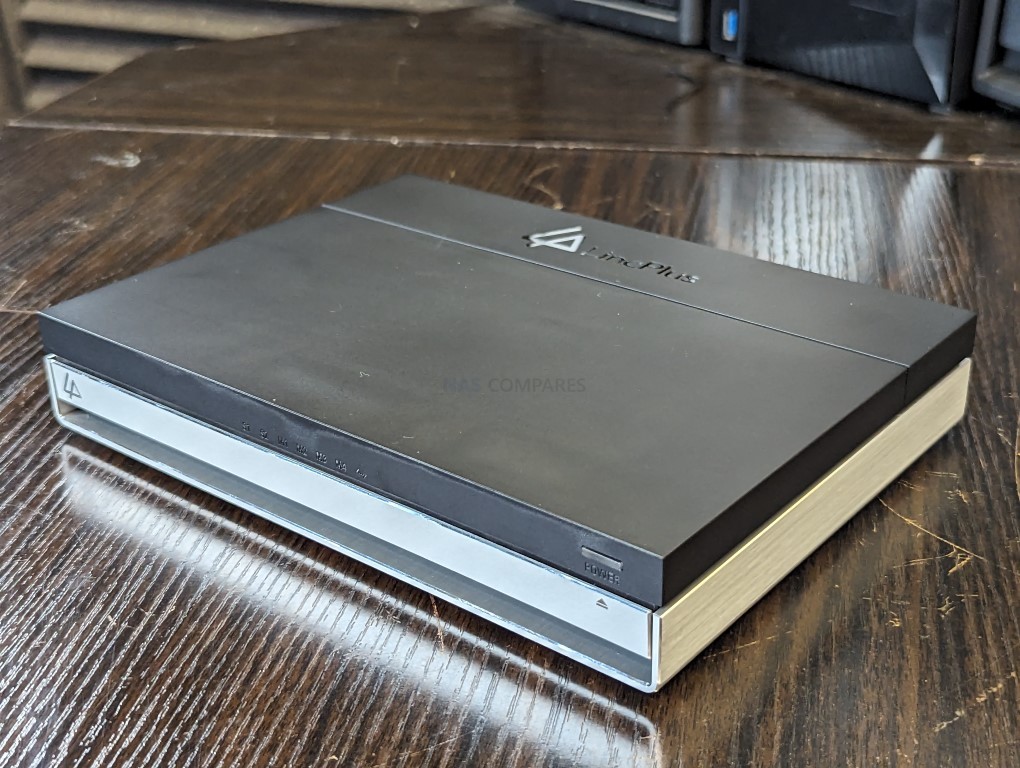
The growing feasibility of flash-optimized servers for home and small business users in the last 12 to 18 months has been genuinely staggering! Seemingly overnight, the viability of network-attached storage devices exclusively dedicated to using SSDs for their primary storage has not only become exceedingly desirable but also accessible! Maybe it’s the continuing evolution of modern computer architecture that helps harness the higher performance SSDs are capable of? Perhaps it’s the continuing decrease in the price of SSDs that, although still not comparable to that of slower hard drives in terms of capacity and price per TB, has led to the increased popularity of SSD mass systems. For whatever reason, 2023 (and indeed 2024 if new product news continues the way it has) is becoming a dominant year for hardware solutions that have migrated away from slower mechanical drives and towards fully optimized SSD deployment. Into this exciting arena, we find the Lincplus Lincstation N1, an UnRAID license-bundled turnkey 6-Bay SSD NAS that is about the size of a paperback book. First formally revealed to the public at IFA 2023 in Berlin and soon to arrive on Indiegogo at quite competitive pricing, this new SSD-focused 6-bay NAS is not only challenging the typical price point of home and prosumer NAS solutions but is also debating whether HDD-focused NAS servers have outstayed their welcome. I was fortunate enough to be sent a first-generation Lincstation N1 for review, and today we want to dig in and find out if this small system is big enough to make a dent in the established world of network-attached storage.
Hardware Specifications in brief:
- LincPlus LincStation N1
- Coming to IndieGoGo Soon, $279 Launch Price
- Silent 6-Bay M.2 NVMe NAS Drive
- UnRAID Standard License Included
- 4x M.2 NVMe SSD Bays
- 2x SATA 2.5″ Hot Swap Bays
- INTEL CELERON N5105 2.0-2.9Ghz
- 4-CORE/4-THREAD 64BIT x86 CPU
- 16GB DDR4 MEMORY
- 1x RJ45 2.5GbE
- HDMI 2.0b 4K 60FPS
- 2x USB 3.2 GEN 1 (10G)
- 1x USB-C Connection
- Fanless Design
- 60W External PSU
The Lincplus Lincstation N1 NAS Review – Quick Conclusion
The Lincplus N1 NAS, priced at $279, offers impressive hardware capabilities, especially when considering its silent operation, bundled UnRAID software, and turnkey deployment. Although certain concessions, like the absence of ECC memory and bandwidth limitations on m.2 NVMe slots, were made to hit this price point, the system presents great value. UnRAID, while user-friendly, has a learning curve, and some of its default settings could better match this SSD-centric system. However, the N1 serves as an attractive alternative to full DIY setups, bridging the gap between custom-built and ready-to-use solutions.
| Where to Buy a Product | |||
|
|
    
|

|
VISIT RETAILER ➤ |
 |
    
|

|
VISIT RETAILER ➤ |
 |
    
|

|
VISIT RETAILER ➤ |
 |
    
|

|
VISIT RETAILER ➤ |
The Lincplus Lincstation N1 NAS Review – Packaging
The presentation of the Lincstation N1 is quite petite and modest when compared to a number of other six-bay solutions in the market. Arriving in a small black carton with only the brand’s logo and model ID denoting the content. Given that this product is going to be rolling out on Indiegogo relatively soon, I was somewhat surprised by the level of completion here on the retail kit.
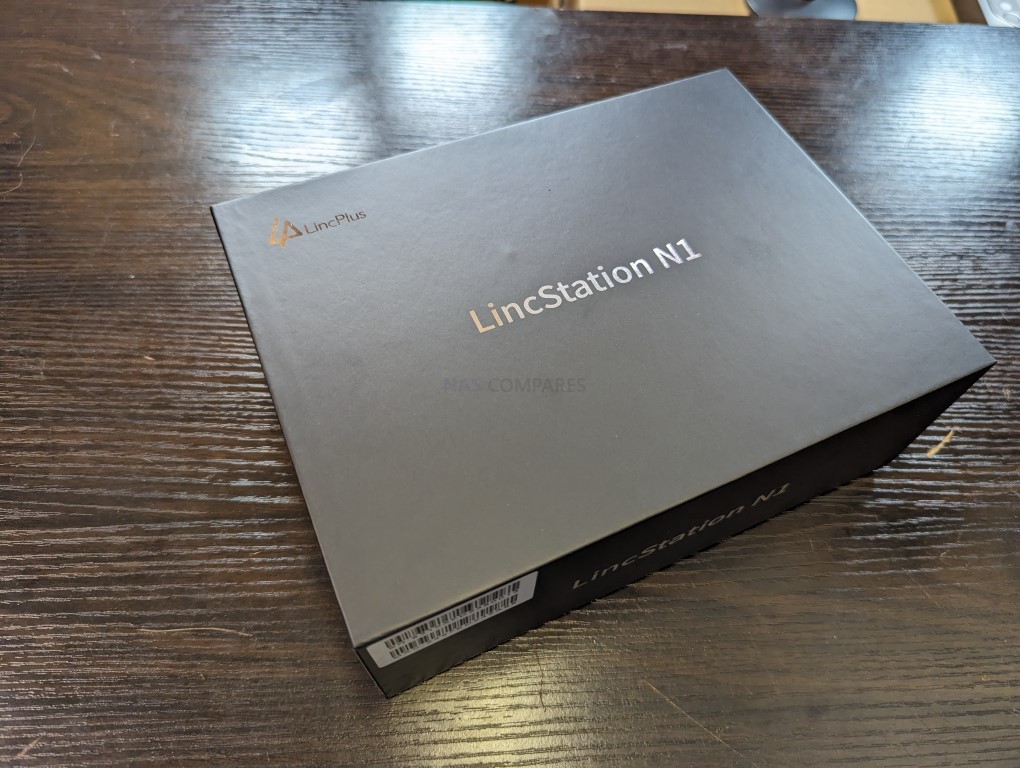
Quite neatly presented, though light on actual contents, the kit includes an external 60-watt power supplier, first-time setup instructions, and the N1 NAS device itself. That’s really it; the device doesn’t arrive pre-populated (what exactly did you expect for $279?) and doesn’t even include an ethernet cable. Yes, in an age of awareness of e-waste, I can see the logic behind not including an ethernet cable, but even just to flesh out the retail kit, this would have been a good addition.
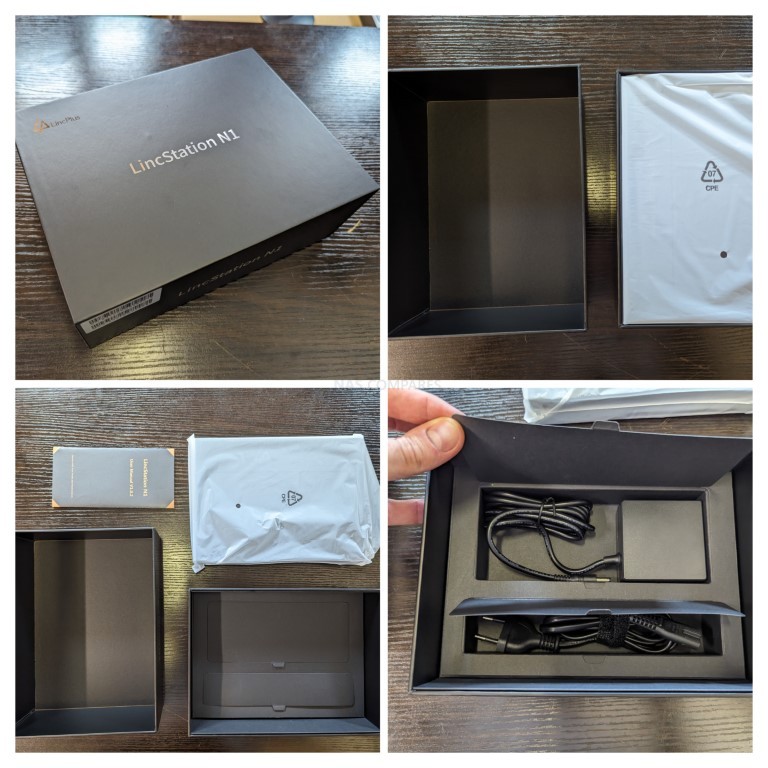
The PSU is of pretty high quality, and instead of the typical elongated brick, the system comes with a much more compact square block. This choice makes sense for the external PSU, not just considering the modest Celeron processor and sleek chassis, but also because internal PSUs often generate a bit more heat. An SSD-focused NAS device like this one needs to be highly efficient in heat dissipation.
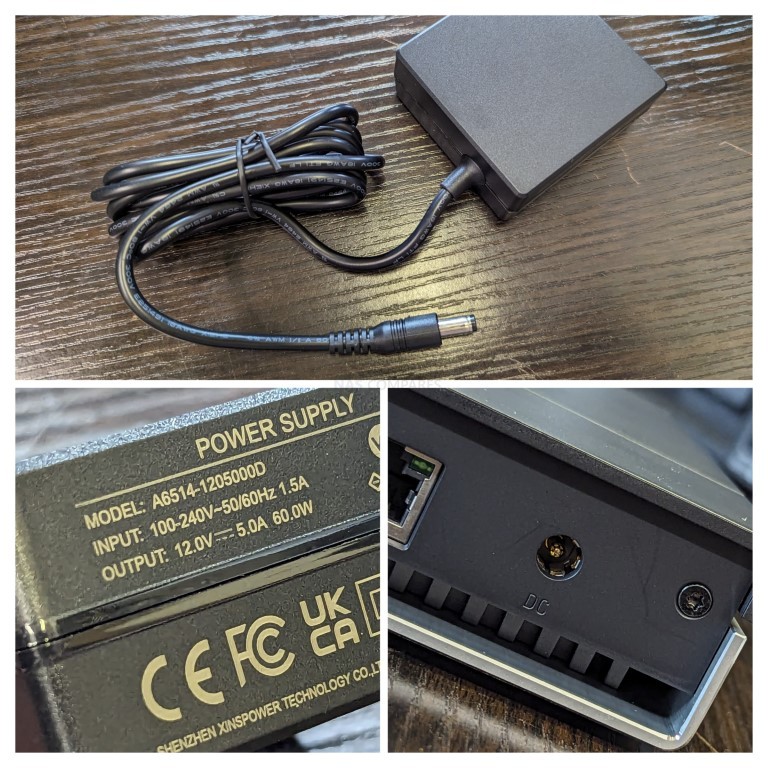
The retail carton presentation for a device still making its way through crowdfunding is quite impressive. It’s evident that style and first impressions are pivotal for the target demographic of the N1. Now, let’s delve into the physical design of this flash NAS that’s compact enough to nearly fit in your pocket.

The Lincplus Lincstation N1 NAS Review – Design
The external chassis of the Lincstation N1 is only slightly larger than a paperback book and merely an inch bigger than a traditional 3.5-inch hard drive. Much of this compactness is due to the device’s emphasis on the smaller solid-state drive storage media rather than the bulkier hard drives. Yet, the fact that this device houses four M.2 NVMe slots and two 2.5-inch SATA slots while maintaining such a petite frame is remarkably impressive. Additionally, the system operates almost silently. Those seeking a media center or a close proximity server and are sensitive to noise will likely be very pleased. The chassis design is decidedly modern, yet it somewhat evokes the nostalgia of an old VHS player, albeit in a much smaller form.

Although the N1 boasts a compact chassis, when placed next to a standard M.2 NVMe SSD for comparison, it’s evident there’s substantial enclosure protecting the storage. A significant portion of this is dedicated to heat dissipation when the drives are active. While the performance and speeds of these SSDs might be limited to minimize heat generation, efficient heat dispersal remains a crucial focus. This is achieved through strategically placed panels for heat dissipation, precise thermal padding placement, and a vented design around all four edges.
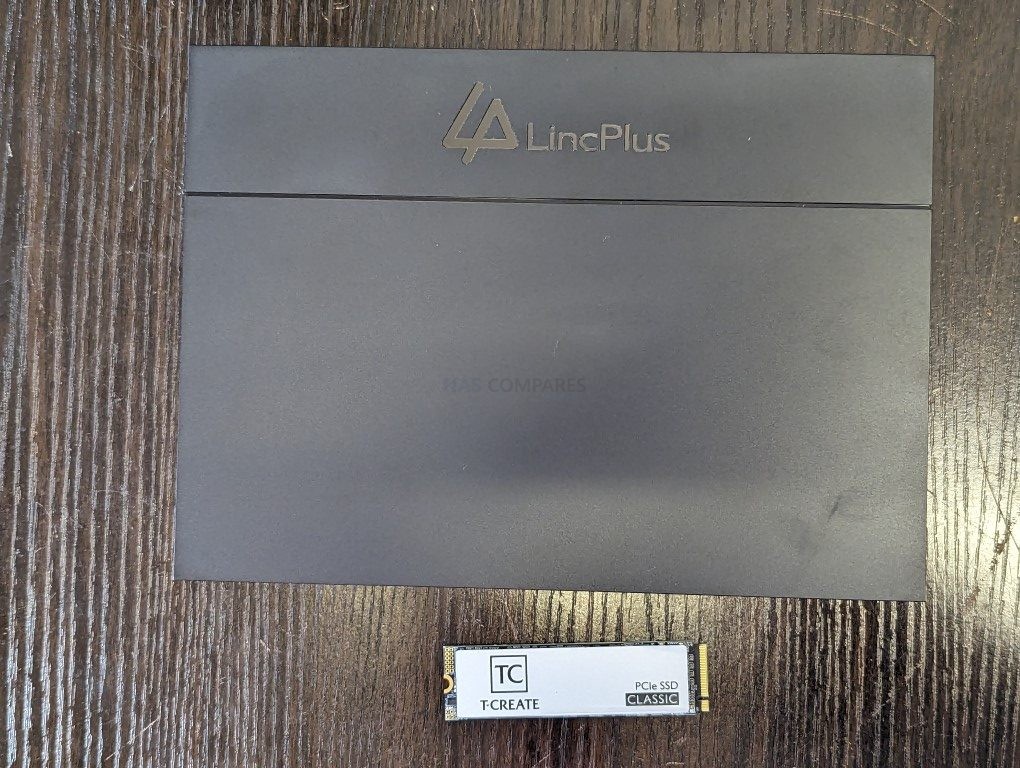
The 2.5-inch SATA bays are concealed behind a flip-down cover panel, revealing two individual slots. These SATA bays can accommodate either SATA SSDs or budget-friendly SATA laptop hard drives. This flexibility allows users to potentially set up a hybrid storage system, using the M.2 NVMe drives for primary or frequently accessed storage, while retaining the option to install up to 5TB laptop hard drives in the available bays for auxiliary storage. What’s more, the system comes pre-installed with UnRAID and includes an UnRAID license, offering a ready-to-use solution straight from the packaging. This ensures that none of the storage drives are preoccupied by the operating system. Instead, the system houses an internal USB with the UnRAID boot drive, which then loads into the system memory to run the software. This design ensures that the SATA bays can either serve as rapid access storage or compact archival storage using the laptop hard drives. It’s a novel approach to two-tier storage, deliberately omitting 3.5-inch hard drives in preference for more compact, quieter, and energy-efficient alternatives.
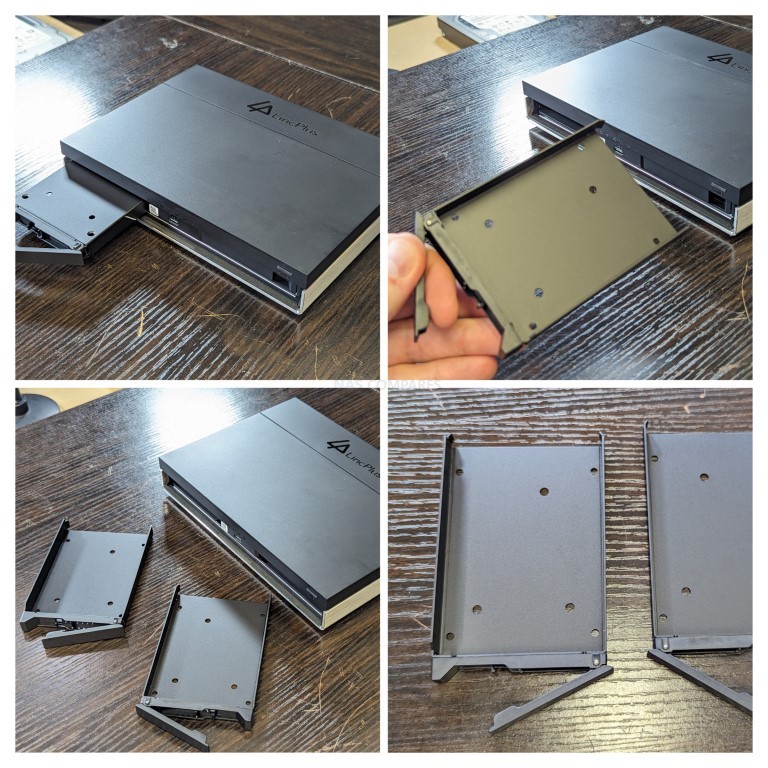
Between each of the 2.5-inch SATA bays lies a USB-C port, suitable for additional storage or compatible USB peripherals. The system also showcases six distinct indicators for each of the storage drives, network activity, and general system power status. When the protective flip cover is securely closed, it produces a striking rainbow LED sequence during system boot-up and a subtle blue light strip reflecting off the base while in use, adding a touch of aesthetics to its functionality.
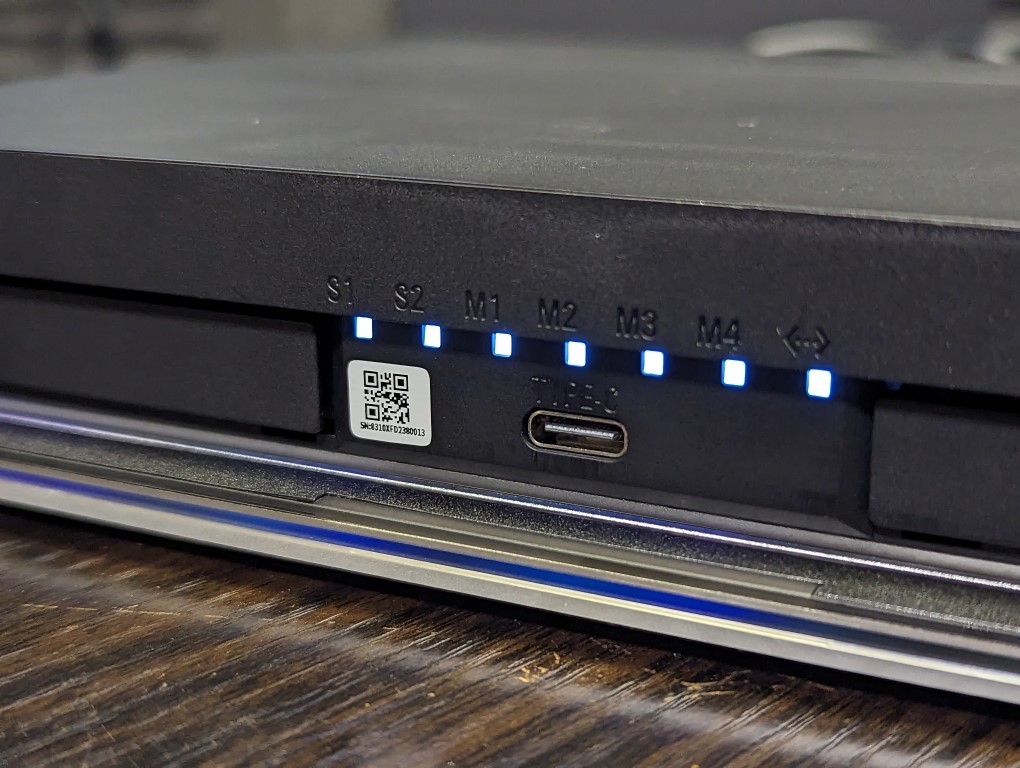
Whether by accident or design, the Lincplus N1 exudes a modern and distinctive visual charm when powered on. Few NAS devices on the market can genuinely be labeled as visually pleasing, with most leaning towards functional pragmatism over finesse. However, in the case of the Lincplus N1, it appears they’ve struck a fine balance, crafting a NAS system that would aesthetically complement any desktop setting.
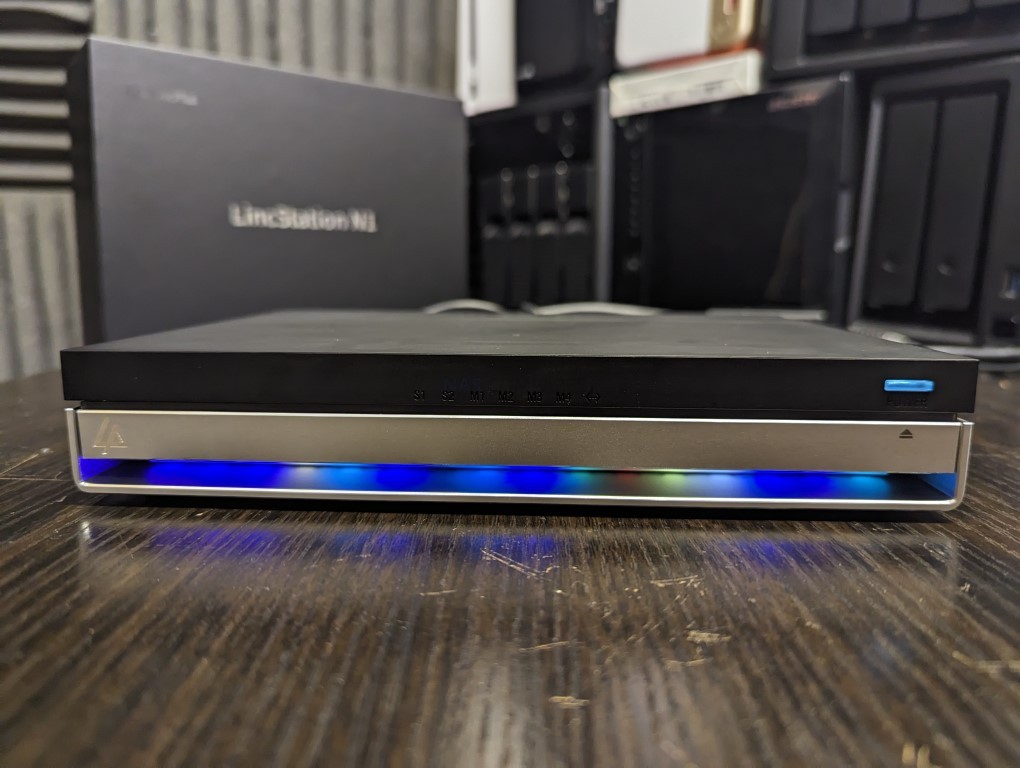
Turning the device upside-down reveals two panels on its base, housing all four M.2 NVMe slots. As with most M.2 SSD bays in other NAS systems, these aren’t designed for hot swapping. Yet, there’s flexibility in storage deployment: you don’t have to fill all the slots from day one. Starting with just a single drive is an option, allowing for gradual storage expansion over time. This becomes even more advantageous when considering the UnRAID’s parity mechanics and its flexibility to incorporate various drives as and when required.
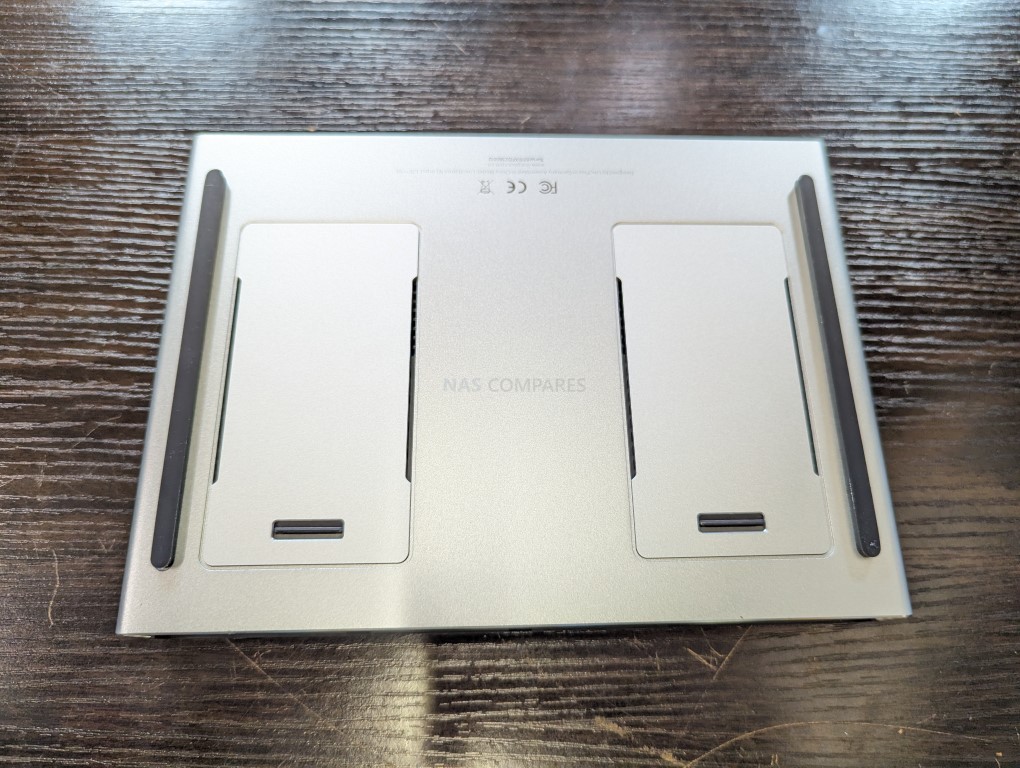
Accessing the bays is a breeze. The cover plate can be effortlessly removed without needing a screwdriver, courtesy of a user-friendly cover panel button. Each of the M.2 bays is equipped with an ejection button, facilitating easy installation or removal of SSDs. Pre-installed thermal pads are present for each bay, but there’s more to their inclusion than just ticking a box. The N1 ingeniously uses the individual M.2 NVMe bay covers as heat sinks. Heat from the SSDs is transferred through the thermal pads to these covers, and subsequently into the surrounding air. It’s worth noting that SSDs in this system can’t use third-party or proprietary heat sinks. Additionally, double-sided SSDs may fit, but rather snugly. Given that the device is equipped with an 8th generation, Gen 3.0 Celeron processor, the peak speeds achievable by these drives might be constrained by the system’s architecture. Thus, the actual heat these SSDs produce might not be as high as one would anticipate. Nonetheless, the design integrates an innovative approach to heat dissipation for each SSD, merging it seamlessly into the overall chassis design.
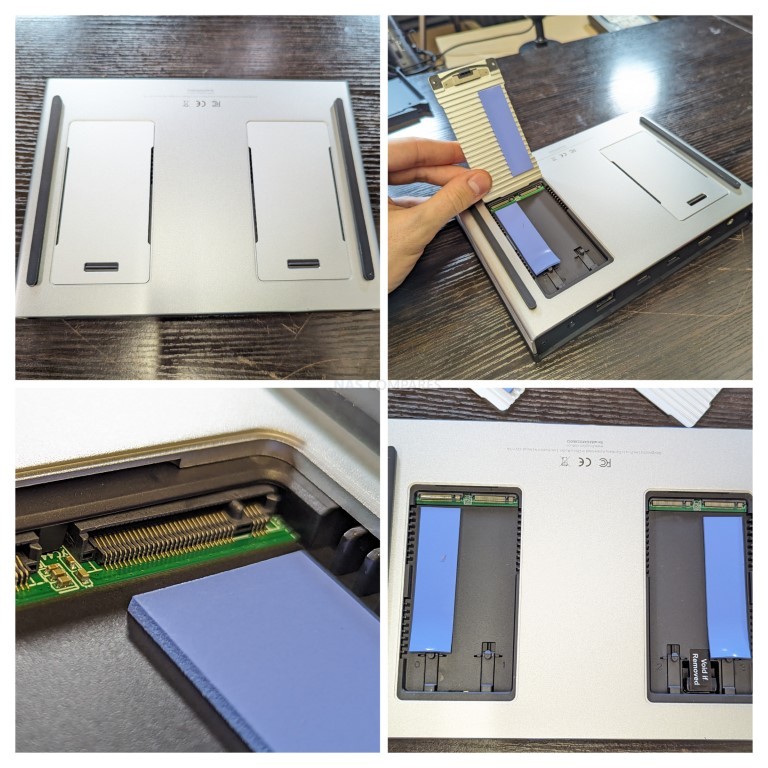
The design of the N1 NAS genuinely appeals to me. While alternative flash-centric desktop devices, such as the Asustor FS6706 Flashstor 6, focus strictly on M.2 NVMe, the N1 incorporates two distinct storage architectures, harmonizing capacity with performance. Surprisingly, it manages to do this while maintaining an even smaller physical footprint in comparison. However, every noteworthy input necessitates a substantial output. And that brings us to the N1’s port and connectivity options, an aspect that left me slightly underwhelmed.
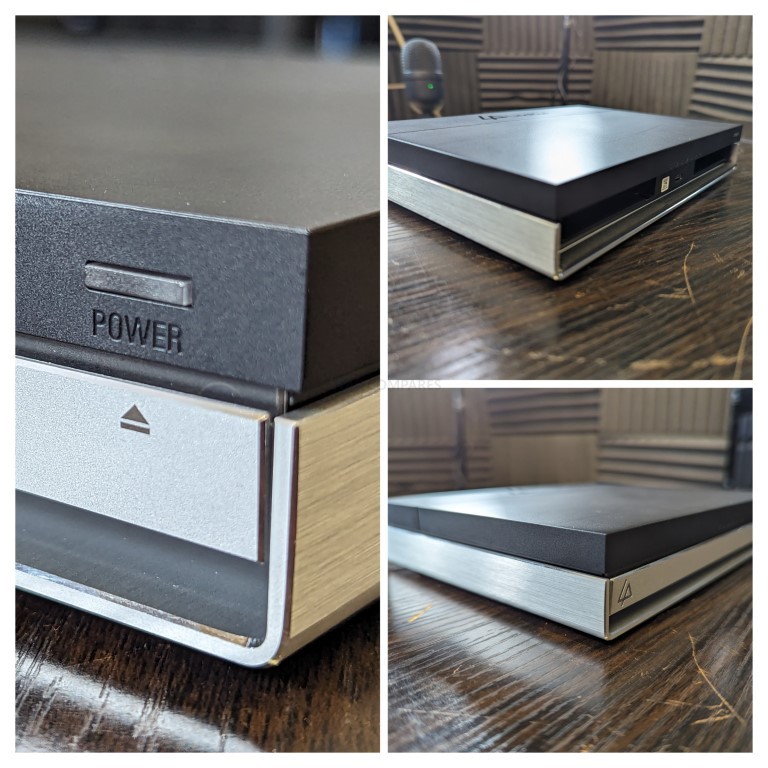
The Lincplus Lincstation N1 NAS Review – Ports and Connections
Considering the N1’s reasonable price point, it’s understandable that certain features might not meet high expectations. While its ports and connectivity align with other 2023 turnkey NAS solutions of this size, they are somewhat lacking, especially when you’re aiming to maximize the potential of all those SSDs.
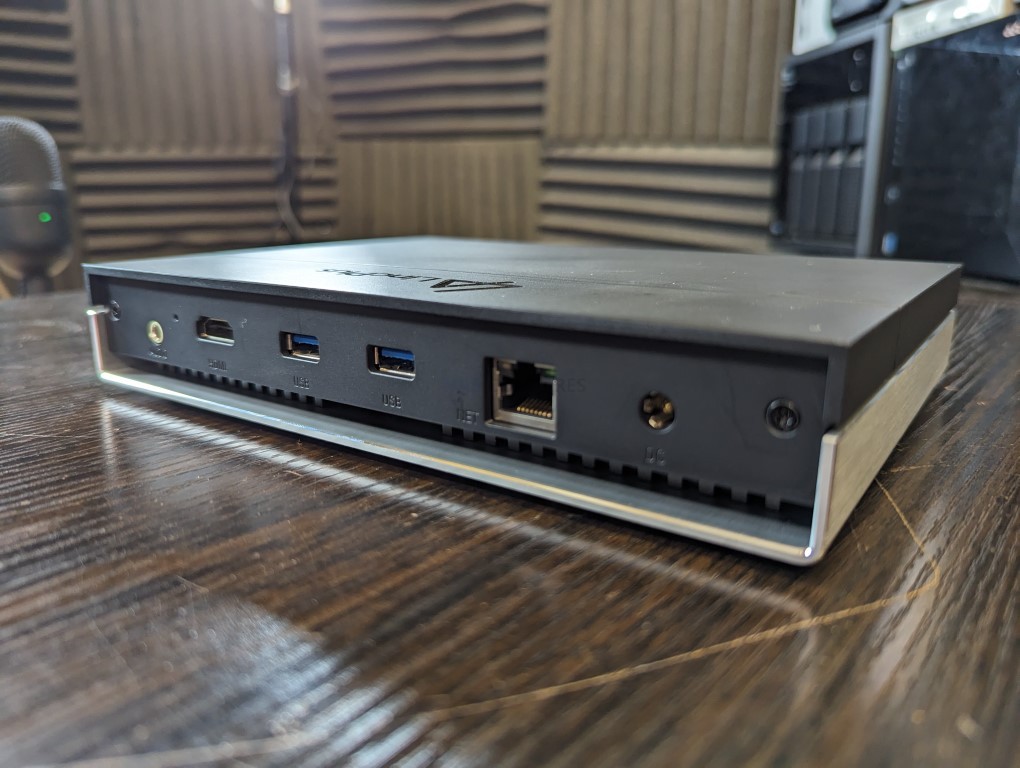
Network connectivity is a mixed bag. On the bright side, the N1 offers 2.5-gigabit ethernet, which has increasingly become the standard for fully featured prosumer and home solutions. This translates to potential external connectivity speeds of up to 279 megabytes per second, assuming you’re using a client device compatible with 2.5-gigabit ethernet. Moreover, Wi-Fi 6 support on the N1 ensures potential wireless connectivity of up to 1.2 gigabits with compatible wireless client devices in relatively close range. However, the presence of only a single network interface port means enhanced features such as link aggregation, SMB multi-channel, or even network failover are conspicuously absent. There’s also no option to incorporate a PCIe network adapter for superior connectivity like 10-gigabit ethernet. While there are USB network adapters on the market and the N1 does offer USB connectivity, it’s slightly disappointing to find such limited network connectivity on a device that otherwise promises substantial internal performance potential.
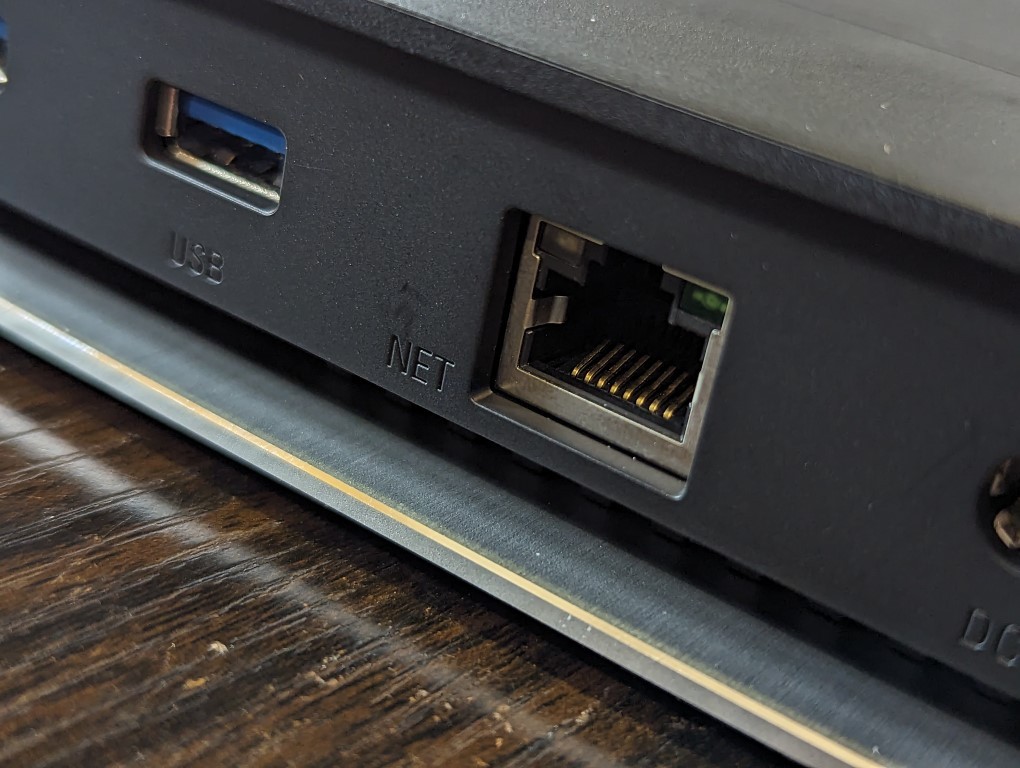
The device boasts three distinct USB ports, all adhering to the USB 3.2 Gen 2 specification, ensuring 10-gigabit performance. While drivers for USB to 2.5G network adapters are somewhat rare, they do exist. This suggests that, with the appropriate software and patches, it’s possible to add an additional network port over USB. Additionally, these USB ports can be used for storage expansion, peripheral support, and even Docker and virtual machine allocation when necessary. However, while these features are useful, they’re fairly standard and don’t particularly stand out.
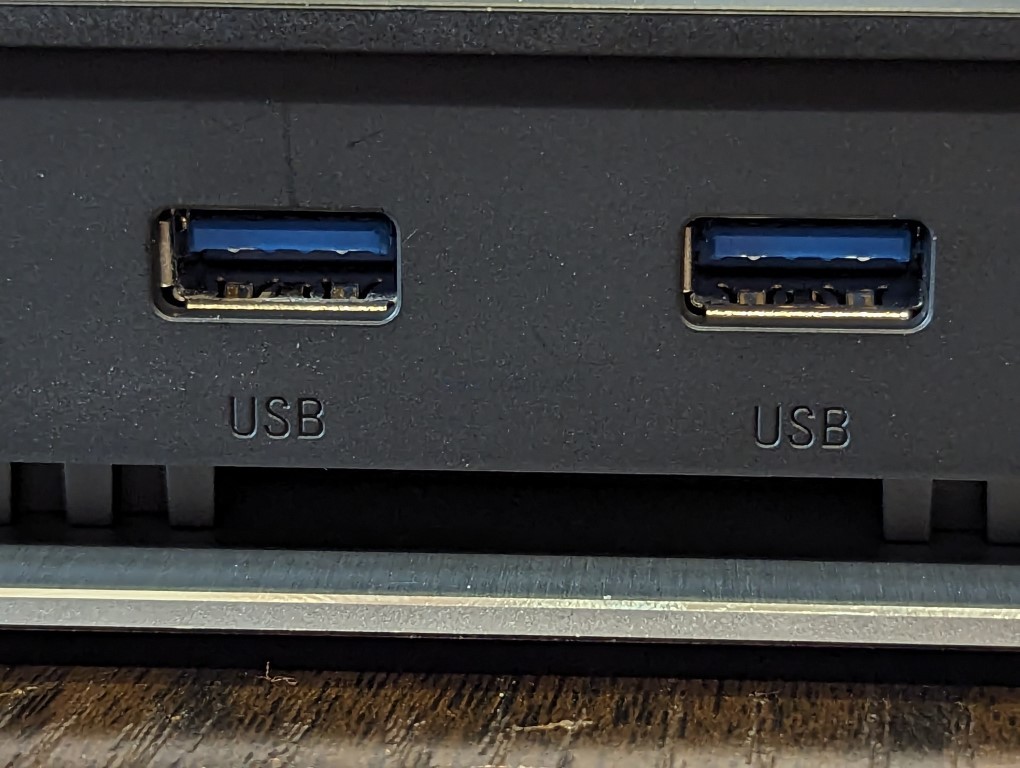
The N1 also comes equipped with a 4K HDMI output that supports 60 frames per second. While Unraid’s direct HDMI output initially appears limited, there are numerous applications available via container and virtual machine tools that can make better use of this HDMI output. If you’re considering installing third-party operating systems on the N1, the inclusion of HDMI and USB peripheral support will undoubtedly be invaluable.
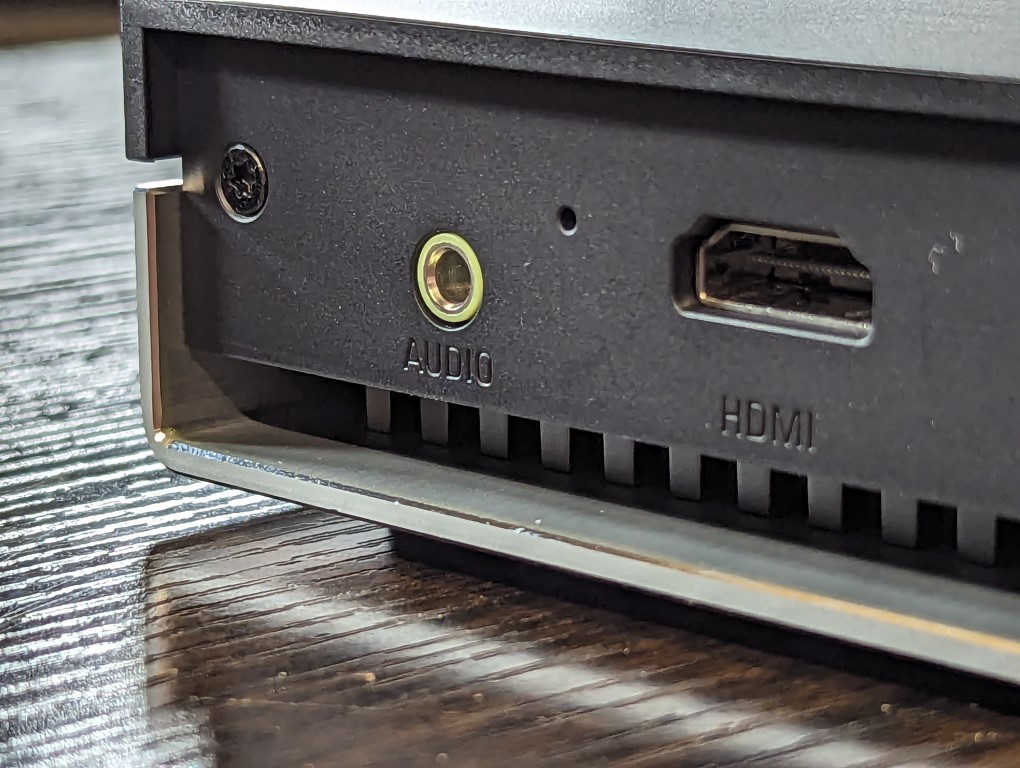
That wraps up the external connectivity. I didn’t emphasize network performance since a solitary 2.5-gigabit Ethernet port, paired with the potential bandwidth from six SSDs, suggests the network port will quickly become oversaturated. While it might seem I’m being overly critical of the N1’s ports and connectivity, it’s important to recognize that at $279, you’re acquiring a turnkey, ready-to-use NAS device with decent standard connections. They aren’t subpar by any means; they just align with what’s expected for late 2023 NAS hardware at this scale. The singular network interface port, combined with limited options for network adapter upgrades, could restrict the potential of your SSD media when accessed externally. Now, let’s delve into the internal hardware and uncover what’s offered at such a competitive price point.
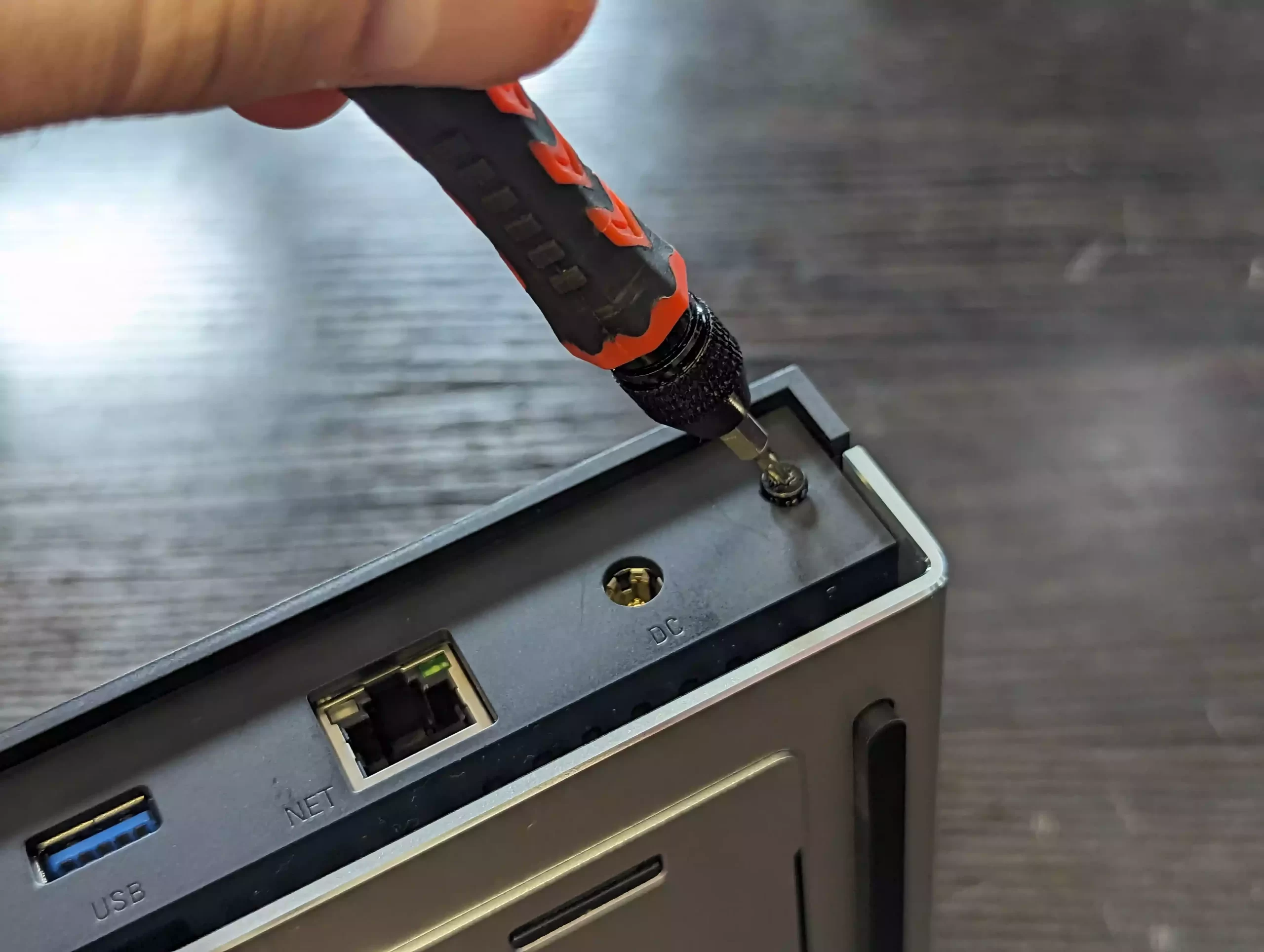
The Lincplus Lincstation N1 NAS Review – Internal Hardware
Earlier, I emphasized that a system focusing on SSD storage, while preserving a compact chassis, needs meticulous internal construction. The Lincstation N1 exemplifies this notion with its impeccably organized internal components. The system lacks an internal fan and relies on strategic heat dissipation and paneling to manage its operating temperatures. Given its limited height, the design options are somewhat constrained, but they’ve made the most of the available space. The majority of the external casing is held together by two rear-mounted screws and a series of interlocking panels. When you remove the main base panel, a T-shaped internal motherboard is revealed.
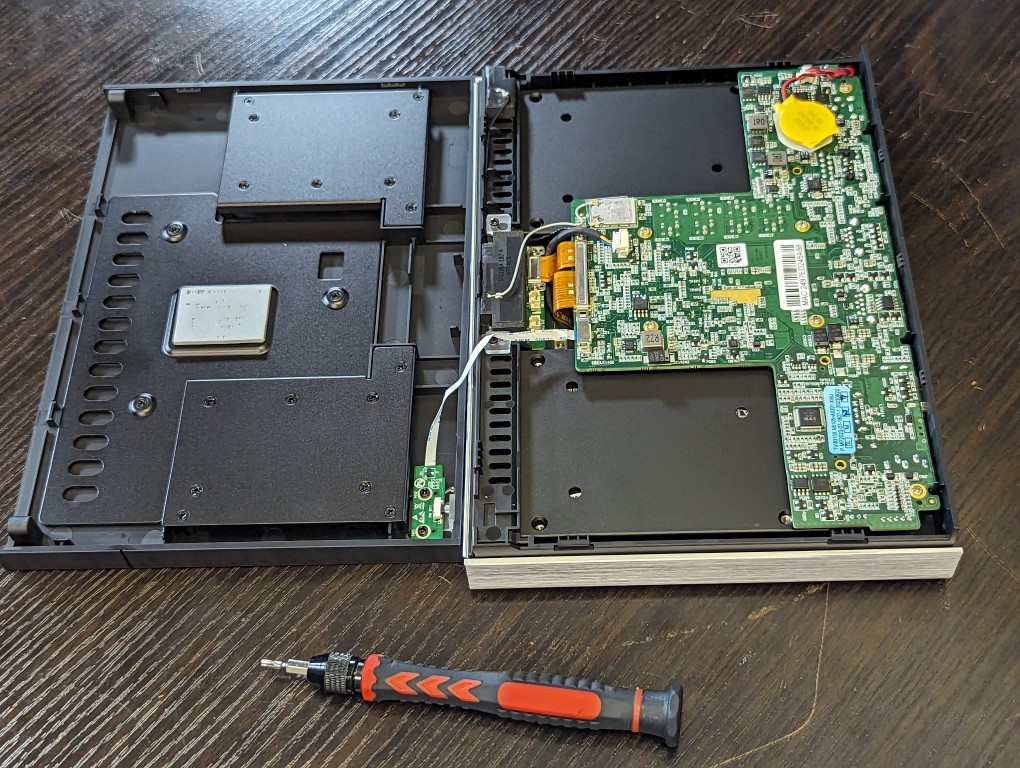
A strategically placed thermal pad can be found on the underside of this panel, aimed at managing heat from the PSU’s underside. However, this doesn’t represent the primary method the system uses to dissipate heat from the CPU. By removing several screws that secure the motherboard to the other half of the N1’s casing, we get a glimpse of the CPU and memory’s location. Generous amounts of thermal paste have been pre-applied to the N5105 CPU, ensuring it adheres securely to the metal side of the casing.
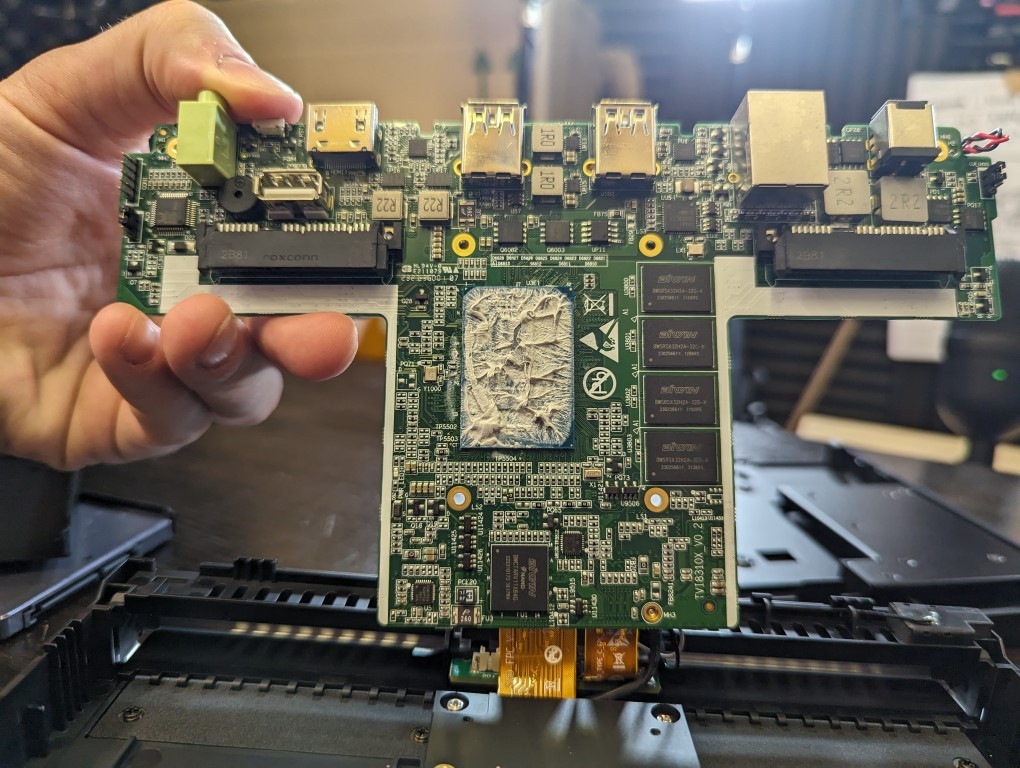
Upon removing several screws that secure the motherboard to the other half of the N1 casing, the location of the CPU and memory becomes evident. The N5105 CPU housed in this device comes with generous amounts of thermal paste pre-applied, ensuring its tight attachment to the metal side of the casing.
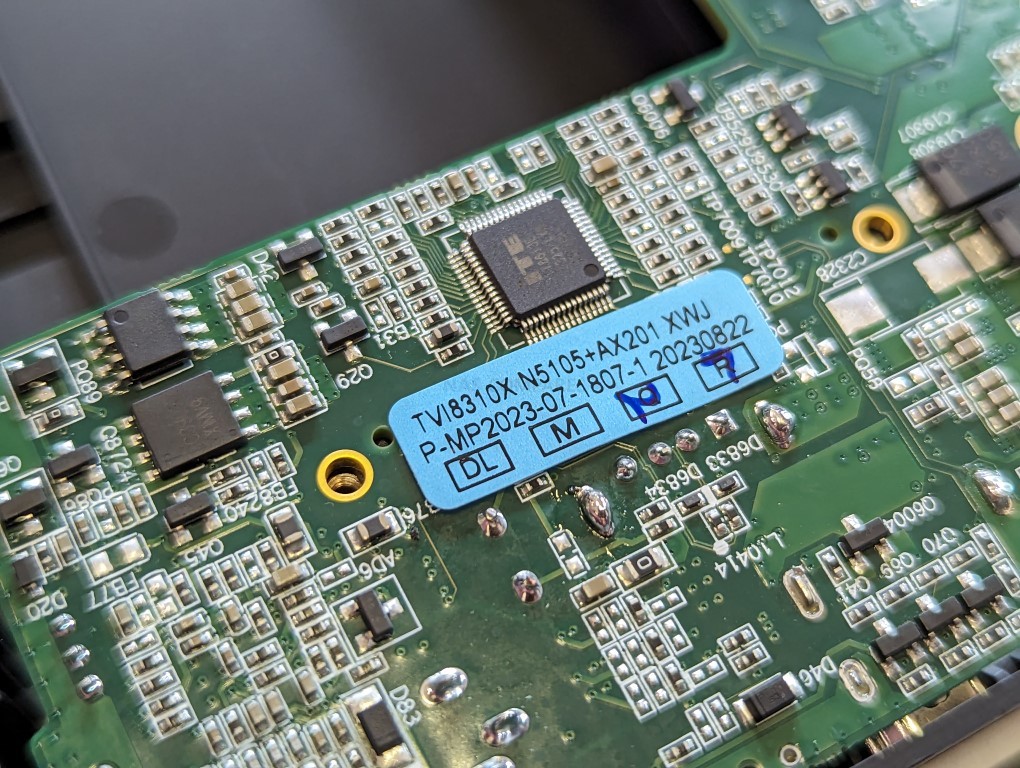
This CPU gained significant traction in 2023, featuring in numerous NAS devices from prominent brands like QNAP and Asustor. It strikes an impressive balance between performance and energy efficiency. This processor excels in prosumer Docker deployments, light virtual machine usage, Plex media server applications (including transcoding and conversion support, courtesy of its integrated graphics), and generally serves as a harmonious midpoint for users who want a blend of cost-efficiency and performance in their NAS hardware.
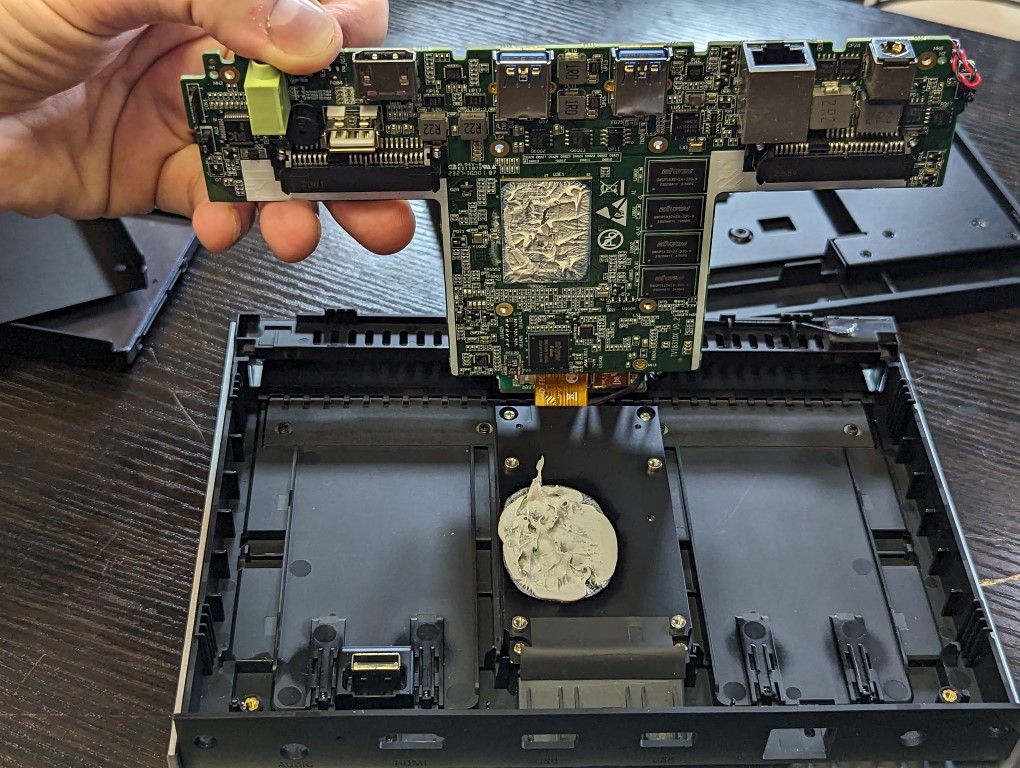
The N5105 is a quad-core, 4-thread, x86 Celeron CPU – one of the last of its kind before Intel’s anticipated switch to the N100 series. With a 10W TDP and its established role in the NAS market, it’s a commendable choice for a NAS priced at $279. However, its capabilities have their boundaries. Being a PCIe Gen3 processor, it only provides eight available PCI lanes to distribute among the system’s hardware. As a result, the m.2 NVMe slots might not reach their full potential.
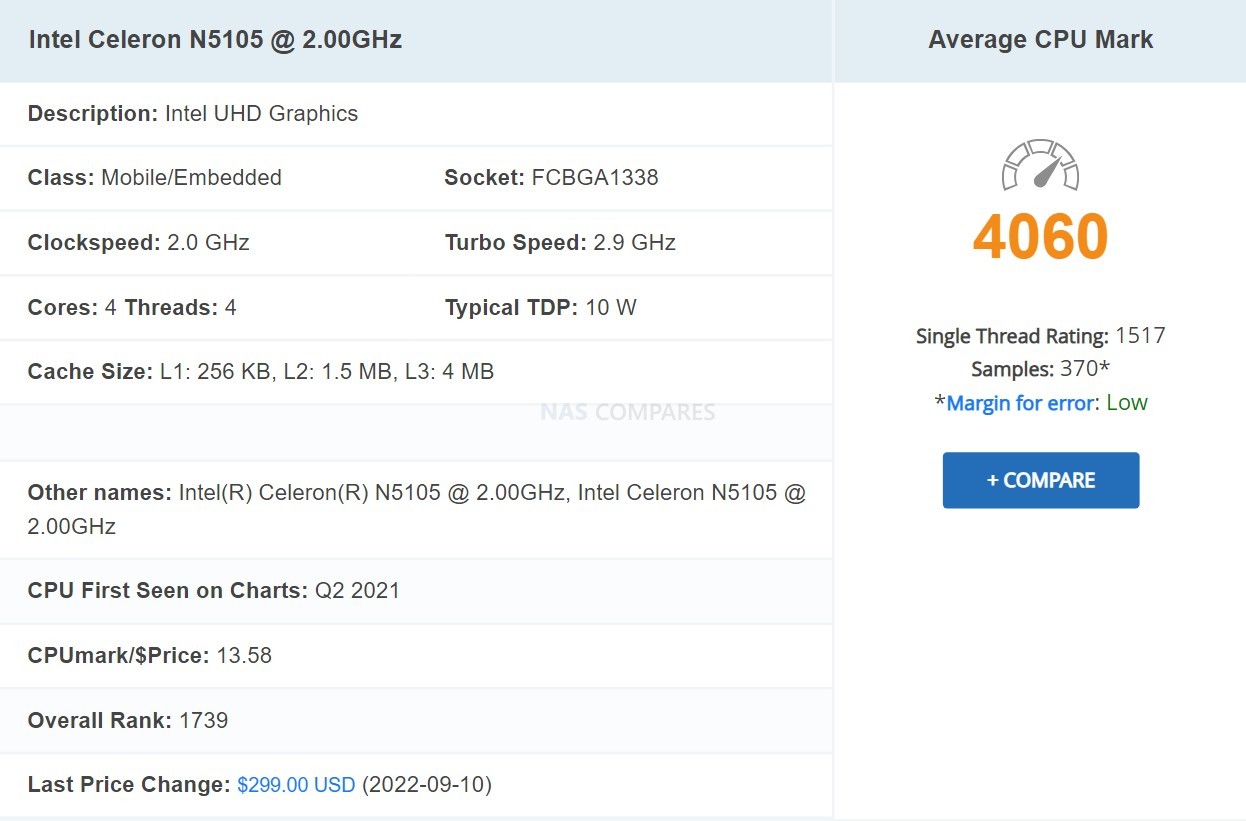
Delving deeper into the device’s backend hardware configuration, we discovered the M2 NVMe slots have been relegated to PCIe Gen 3×1. This might be due to bandwidth constraints or an attempt to regulate system temperatures and prevent the drives from overheating. Regardless of the reasoning, the compact design, coupled with this processor’s constraints, positions the Lincplus Lincstation N1 as a flash system with a relatively restrained potential, especially when compared to more business-oriented flash NAS devices.
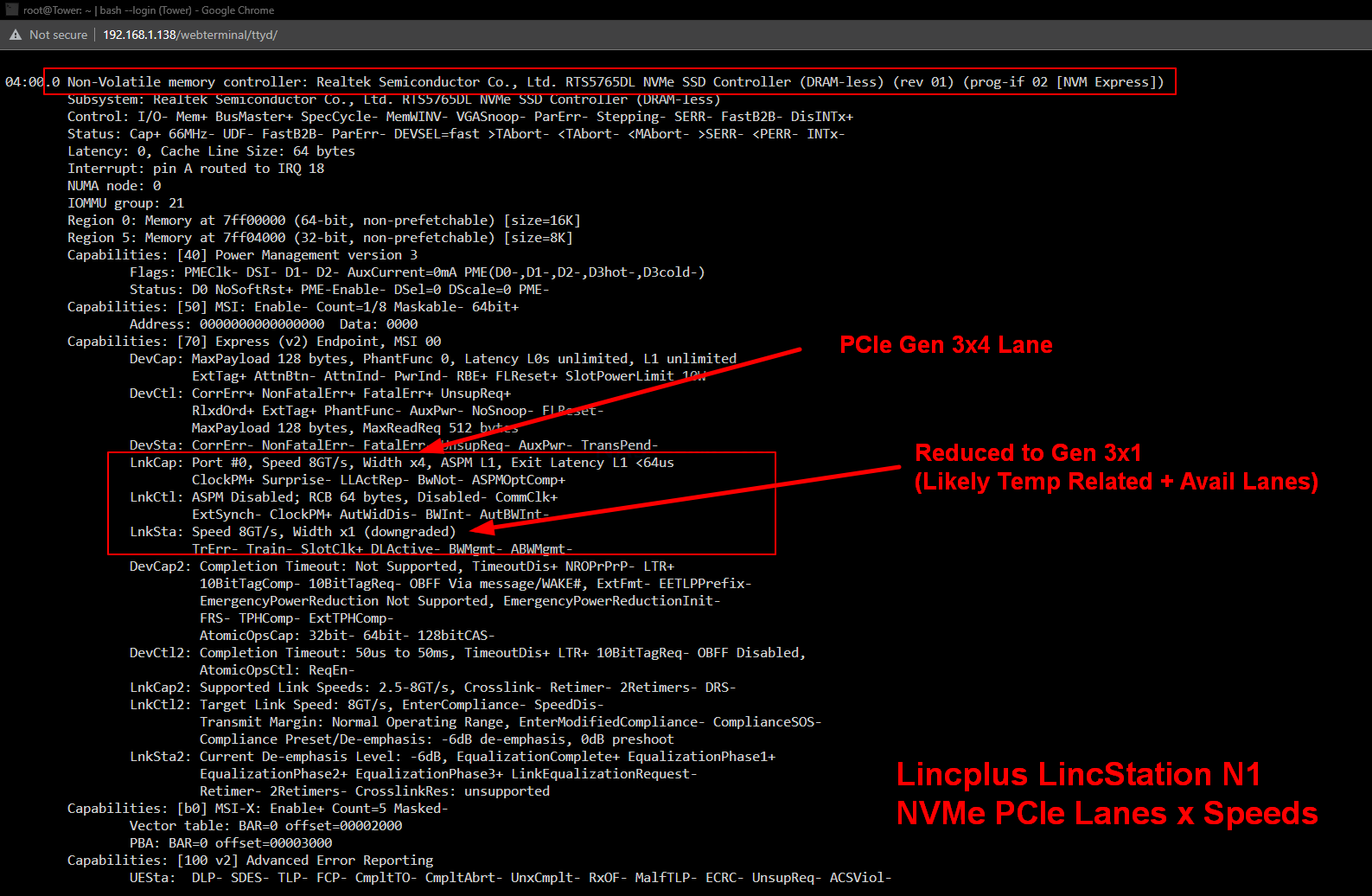
On a brighter note, Lincplus truly outdid themselves with the memory selection for the N1. With the CPU in question, most competing NAS brands would have settled for 4 GB or 8 GB of memory. However, the N1 arrives boasting a remarkable 16 GB of memory right out of the box—the maximum this CPU can support. Instead of opting for a removable SODIMM slot that would permit users to upgrade memory, Lincplus made the bold move to solder the entire 16GB of DDR4 memory directly onto the motherboard’s underside. Generally, this kind of decision would draw criticism as it often restricts users in terms of memory expansion or compels them to shell out more for pre-installed memory they might not initially require. But with the N1, this isn’t a concern at all. They’re offering the highest memory amount this CPU can handle while keeping the device’s price impressively low. It’s evident that Lincplus prioritized their users when deciding on the memory allocation for this system.
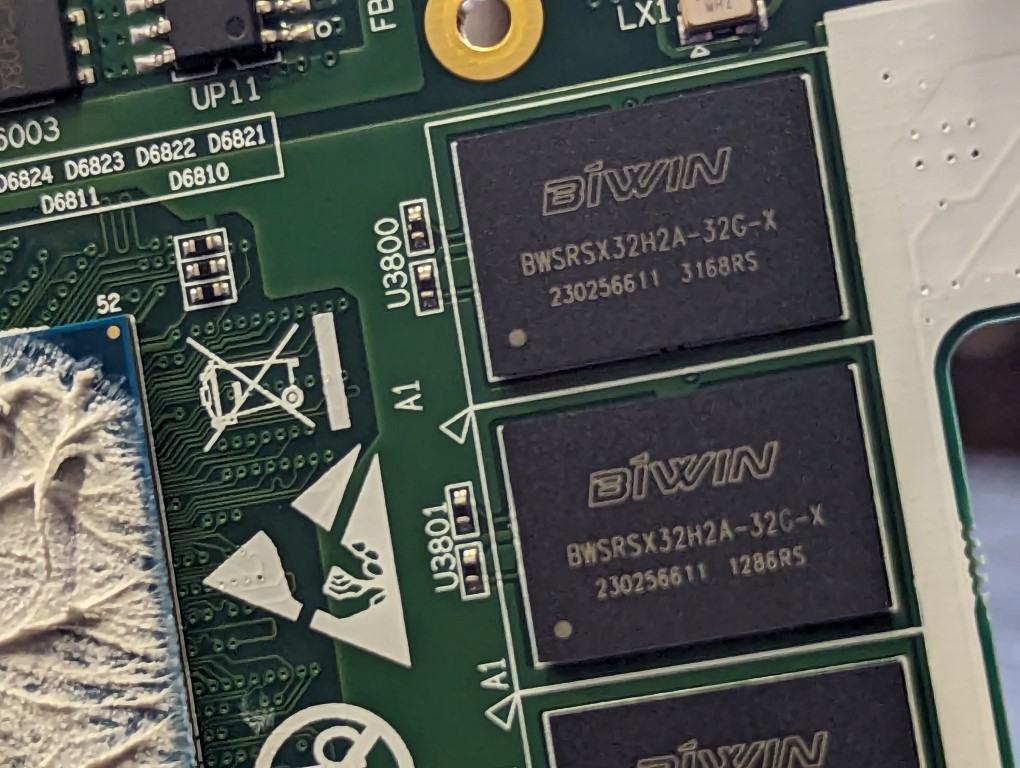
Then there’s the discreet wireless controller. Embedded within the motherboard is a compact Wi-Fi 6 and Bluetooth 5.2 wireless adapter, with two antenna nodes extending towards the front of the chassis. Surprisingly, NAS devices with internal wireless adapters are a rarity. Depending on the specific containers one chooses to operate in UnRAID, or if there’s a preference to replace the OS with Proxmox to simultaneously run an OpenWRT and NAS OS setup, the possibilities for customization are vast. For those less tech-savvy, they still end up with a NAS boasting commendable connectivity options. If there’s any critique to offer, it would be the absence of external antennas or an option for the same, as it might restrict the wireless range and affect wireless data access on the UnRAID array.
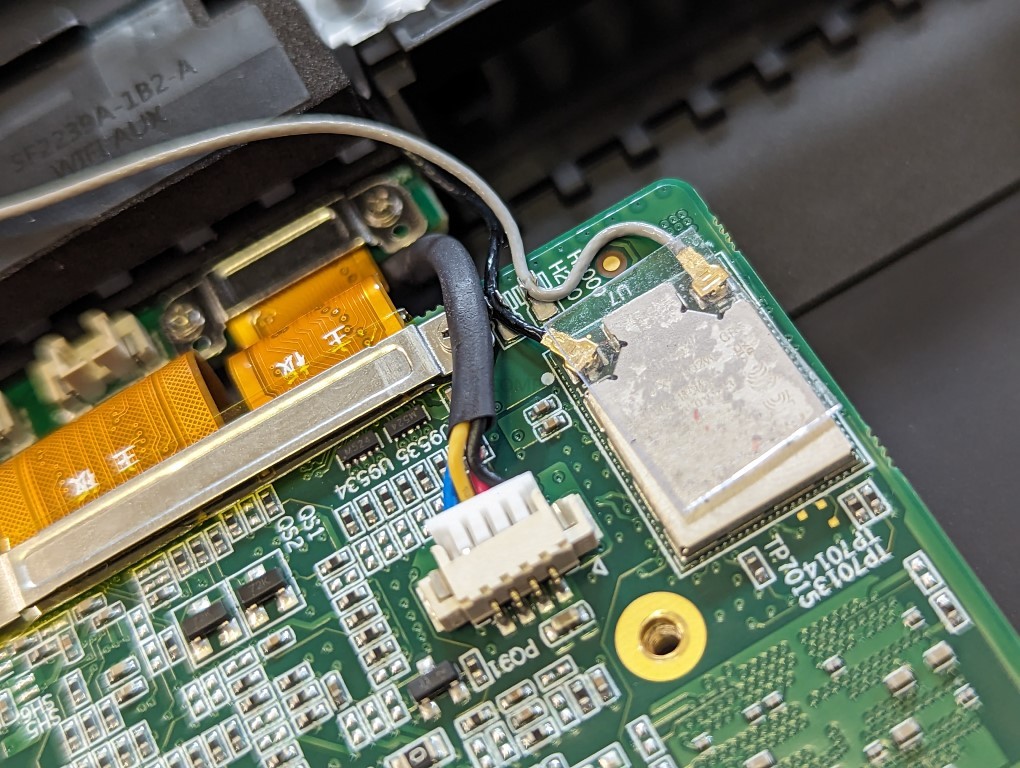
Tucked neatly beneath the primary T-shaped motherboard, there lies an angular USB drive which fits seamlessly into a designated port at the base of the unit. Serving as the heart of the system’s operational capabilities, this USB drive contains the UnRAID NAS software. Upon system boot-up, it seamlessly loads the OS into memory. To highlight its significance, the inclusion of an UnRAID license with this system, especially given its price point, is genuinely commendable. The flexibility of the system design is evident here, as this USB can easily be removed and substituted with a similarly-sized alternative USB, should users wish to introduce different operating systems or hypervisor tools to run multiple OS environments.
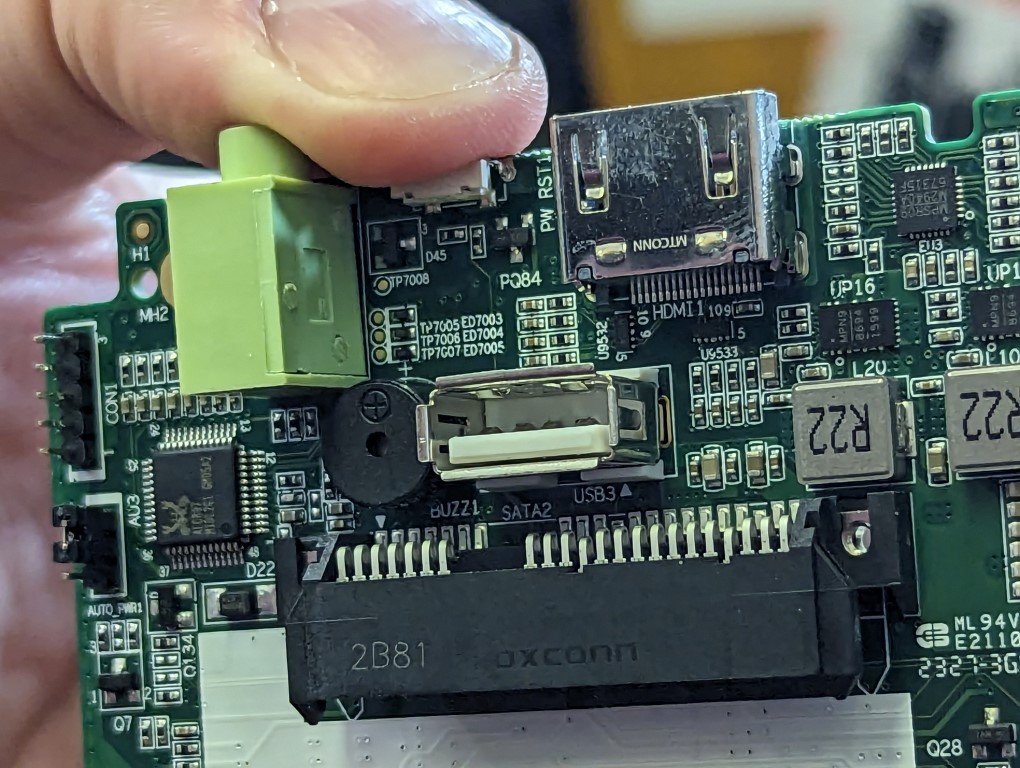
All things considered, when reflecting on the price and the audacious endeavor of packing such hardware into a compact design, it’s challenging to pinpoint substantial flaws in the Lincstation N1’s internal hardware. Admittedly, the CPU isn’t poised to set the business world alight with groundbreaking performance. Moreover, its effect on the m.2 NVMe’s and overall storage performance might leave some wanting. Yet, when contextualizing what this device aims to achieve, coupled with its introductory price and compact size, it’s genuinely impressive. It’s now time to power up the device and delve deeper into the included UnRAID license and software.
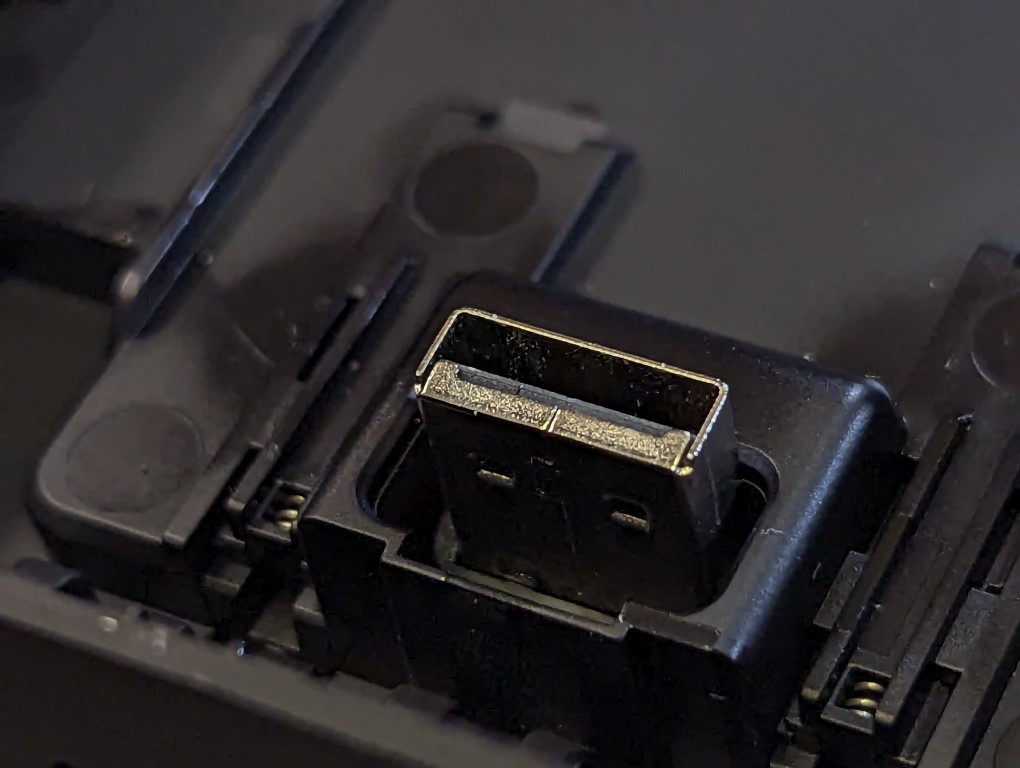
The Lincplus Lincstation N1 NAS Review – Software
It’s vital to distinguish between evaluating the software options of the Lincstation N1 and examining the UnRAID NAS software. While the N1 NAS system is a relatively recent entrant, UnRAID by Limetech has been in the game for a significant period, positioning itself as a premier NAS platform in the industry. Unlike the entirely free but more resource-demanding TrueNAS Core or TrueNAS Scale, UnRAID has carved out a niche among server enthusiasts. It’s lauded for its user-friendliness, often considered superior to many alternative platforms, while also striking a commendable balance by granting users control via the command line.
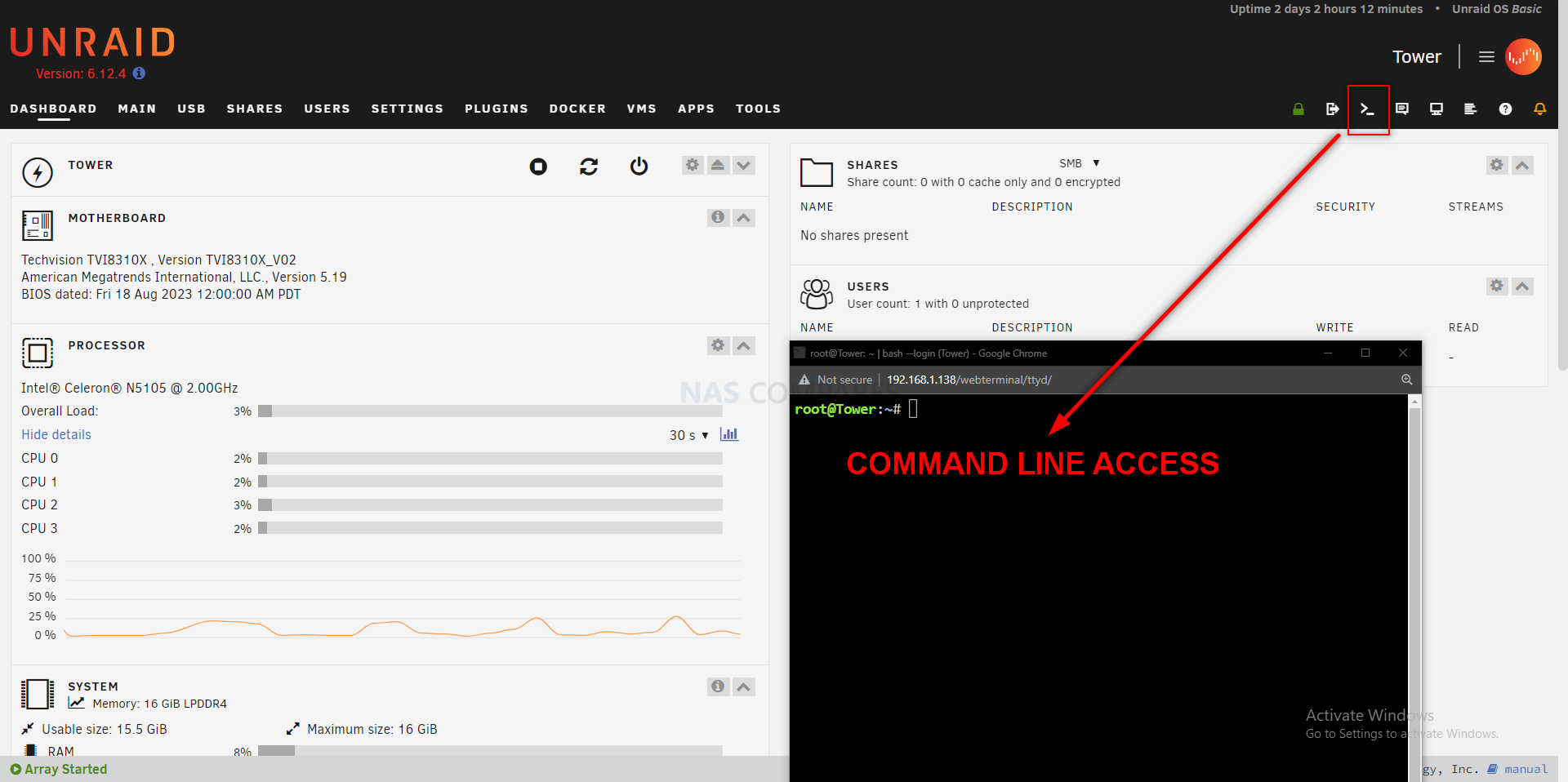
The N1 comes with a standard UnRAID user license packaged in. This means, unlike the DIY solutions where you would have to manually install UnRAID and subsequently purchase a license post-trial period, the N1 simplifies this by arriving pre-configured. It offers everything you’d require to kickstart your UnRAID-driven flash solution right out of the box. There are only a handful of truly turnkey solutions available in the market that incorporate this well-regarded software.
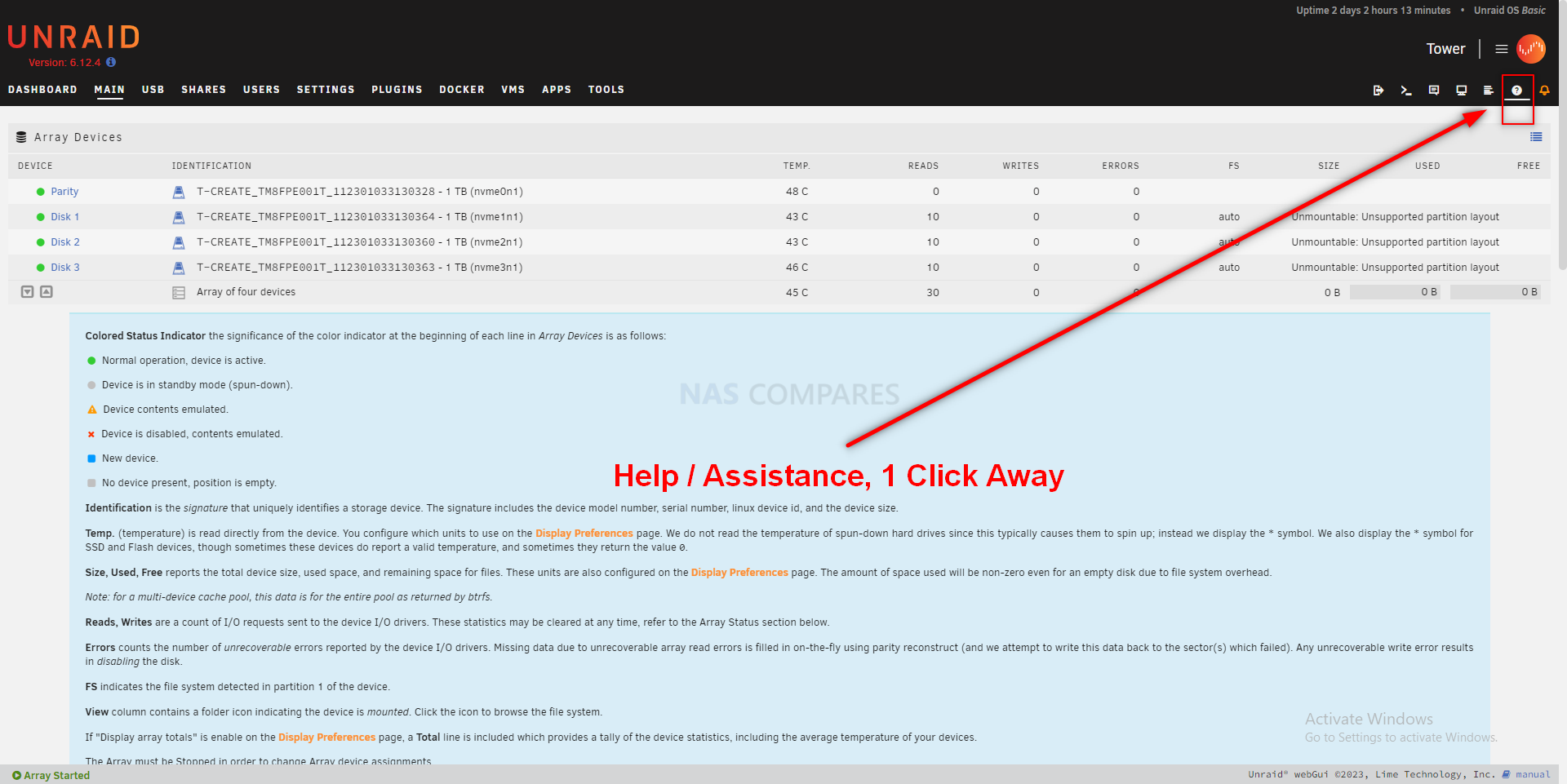
Even though acquiring the license separately isn’t particularly costly, its inclusion in a pre-built, SSD-focused NAS system like the N1 is a rarity. And yes, it might sound repetitive, but all these attributes become even more enticing when you recall that attractive $279 launch price.
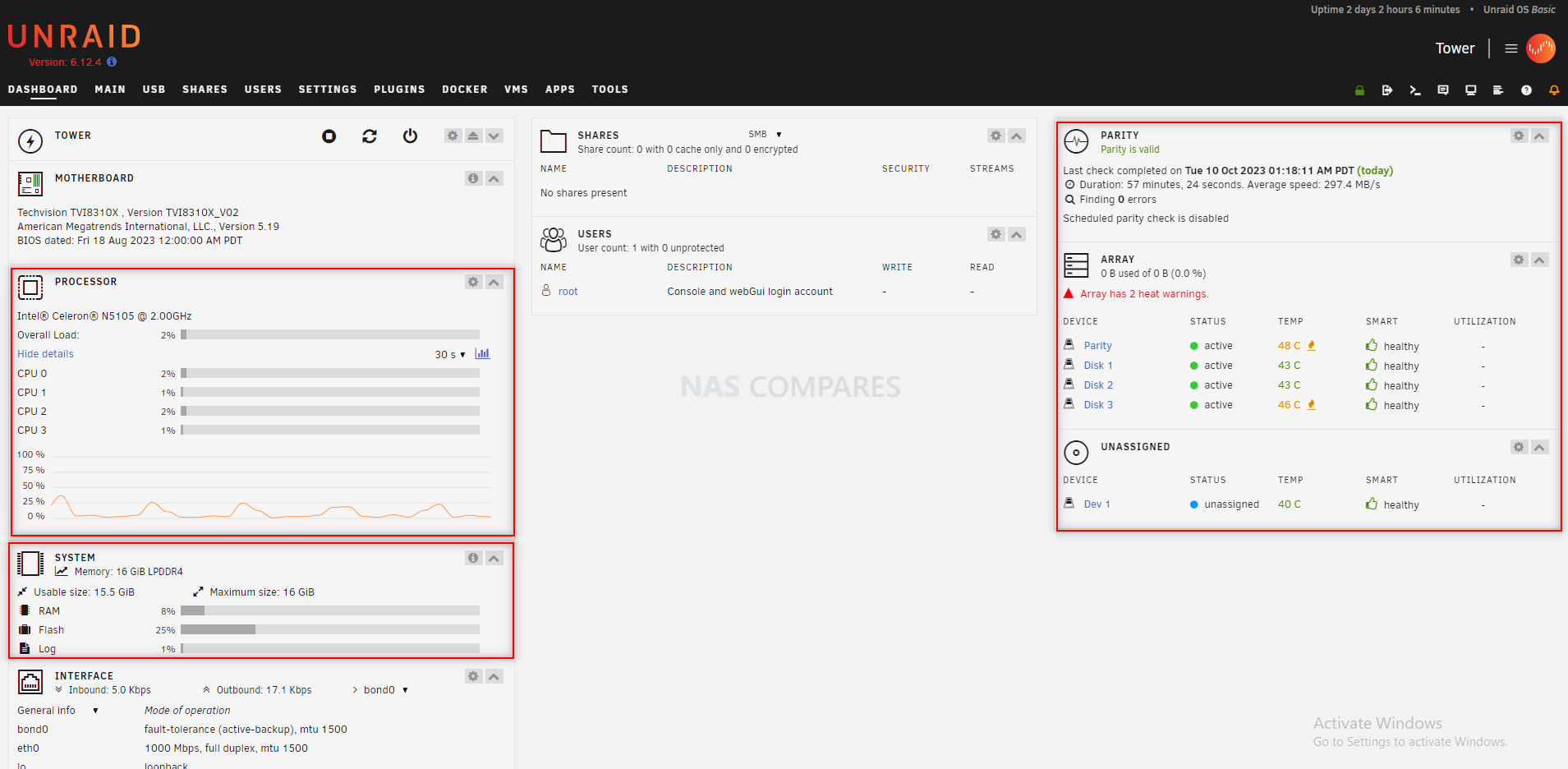
The N1 introduces UnRAID in its default state, with no pre-configured storage array. Given that the system is delivered unpopulated, this is an expected setup. However, its efficiency is impressive: once plugged in, the system boots into the OS, and within a mere three minutes, it’s network accessible. While the core of this article focuses on the N1’s hardware, the software – UnRAID – deserves applause for its streamlined access to container deployment in an incredibly user-friendly manner.
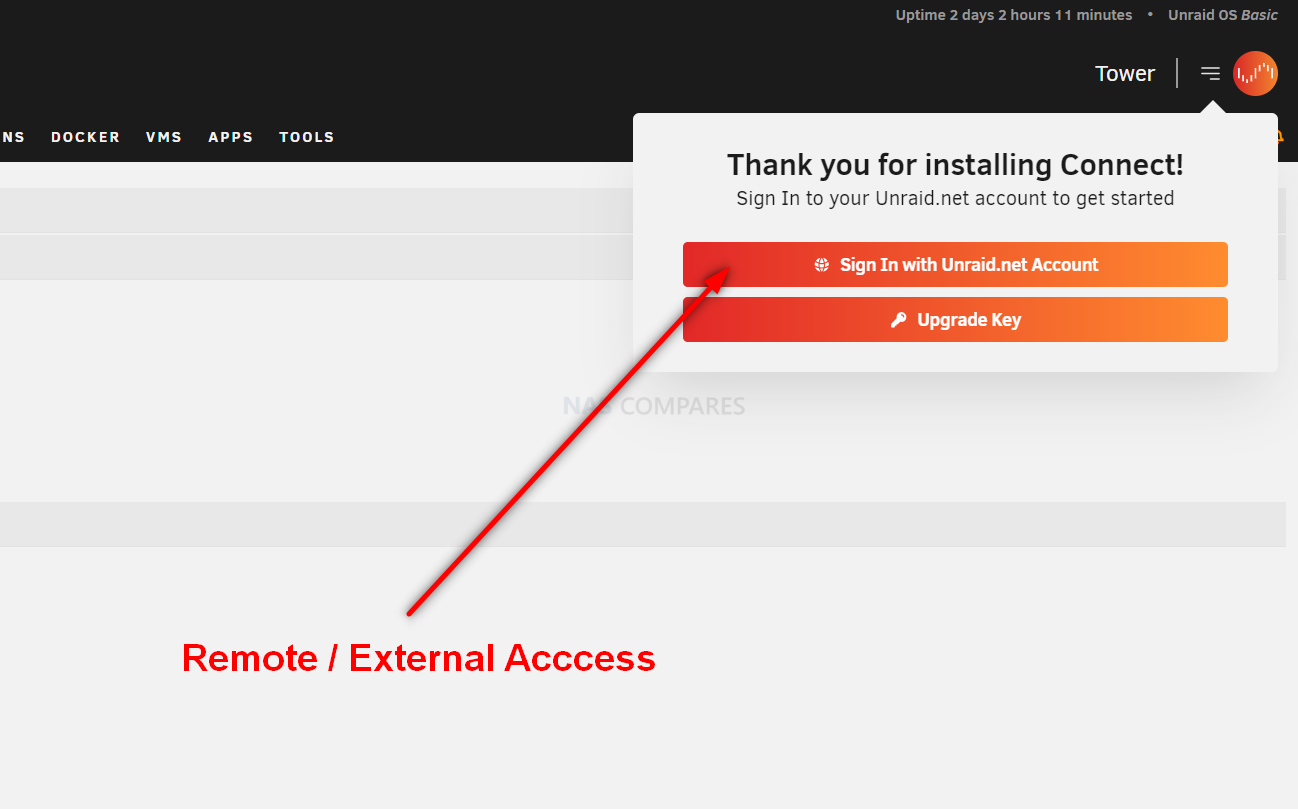
Additionally, the platform offers three detailed, instantly accessible views, supplemented with tips and guidance at any point, courtesy of the help button situated in the top right corner. Lincplus has astutely economized by refraining from building their entire OS from scratch. By including this software license, they’ve seemingly collaborated with Limetech, resulting in a more affordable product.
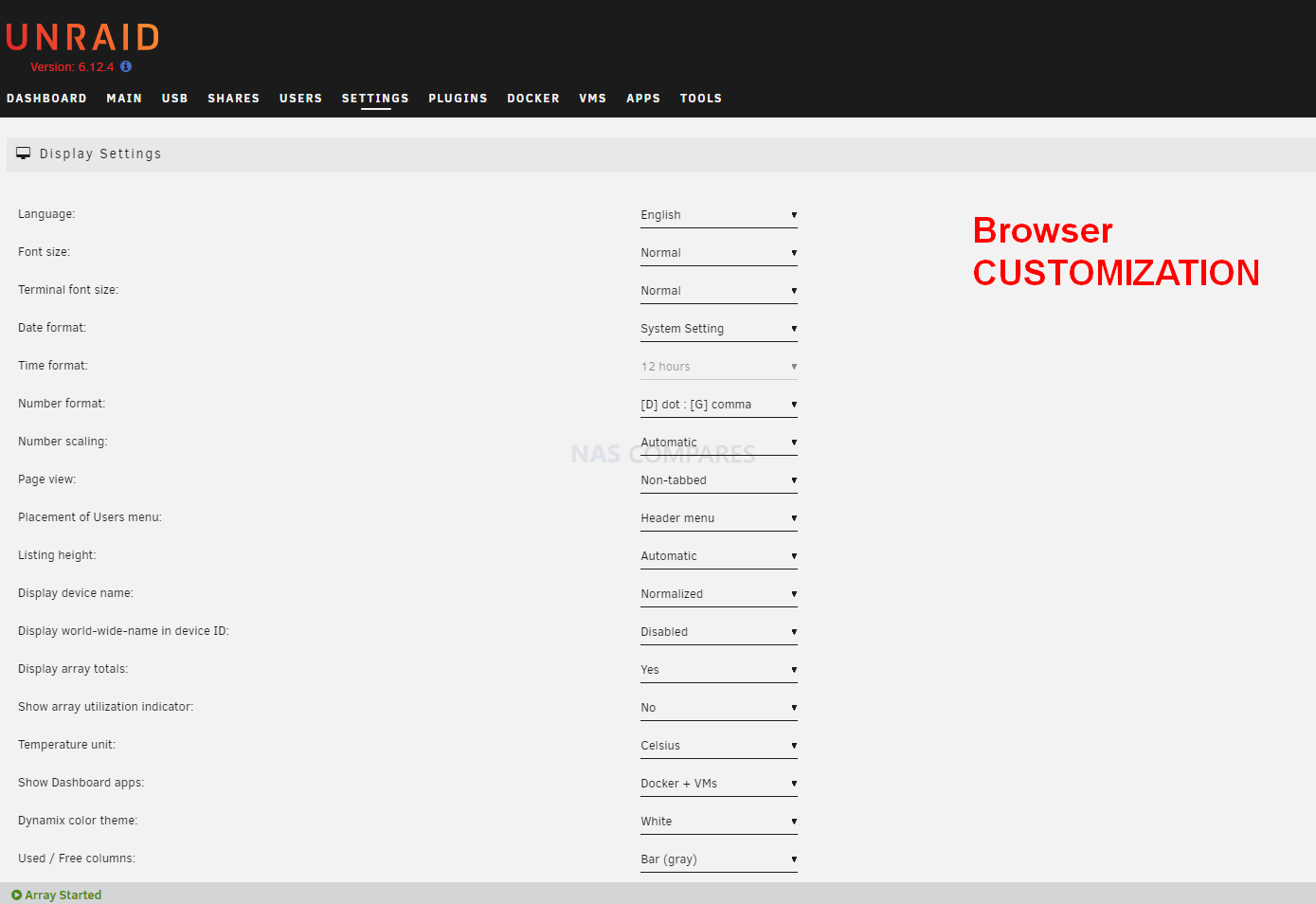
However, the default setup of UnRAID on the N1 does indicate some room for refinement. These are improvements Lincplus could potentially address in future firmware updates rather than being inherent issues with UnRAID. For instance, the default temperature alarms triggered upon the system’s initial power-up need adjustment. Recognizing that UnRAID was originally designed with hard drives in mind, as opposed to the now more prevalent SSDs, the default temperature warnings and alerts for storage media seem tailored for hard drives. The operational temperatures between hard drives and SSDs differ considerably, with mechanical drives typically operating at cooler temperatures. While the N1 is efficiently designed, it doesn’t come without its quirks. Notably, it issues loud alerts and warnings for NVME SSDs reaching just the upper 40° range.

This can be jarring, especially considering that such a temperature is fairly standard for m.2 NVMe drives during write operations. Given the N1’s compact design and the absence of an active cooling fan, the system can be particularly alert-happy. This becomes evident during tasks like disk parity checks or initial array setups, where the system inundates the user with myriad notifications. For those well-acquainted with storage, this might be a minor quibble. However, newcomers to the system, unfamiliar with the typical operational temperatures of these storage devices, could find these alerts disconcerting right from the start.
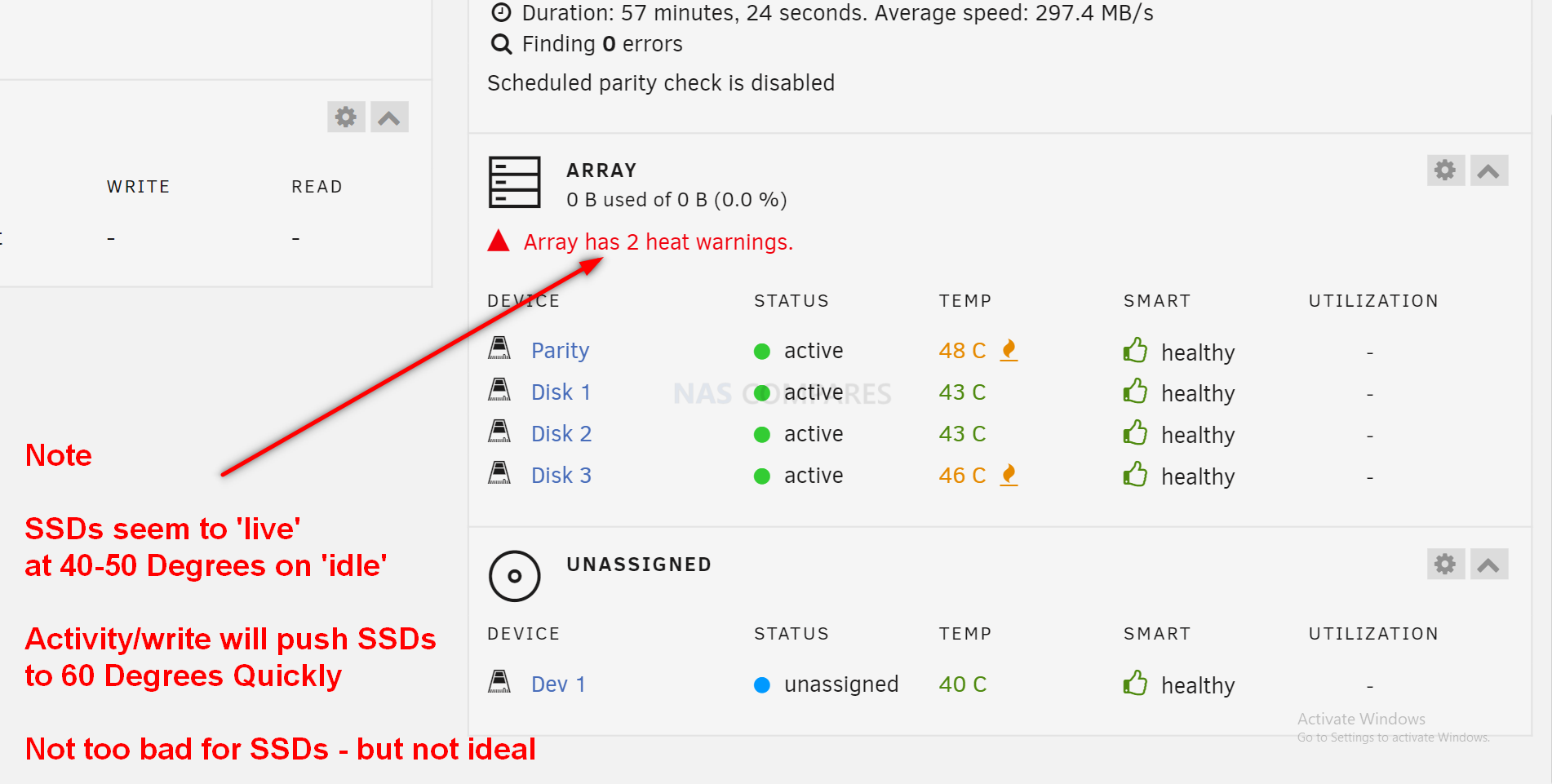
In terms of software features, UnRAID’s container usage might not appeal to every user. Traditionalists might not be fans of the one-click install approach that UnRAID adopts for container installations, opting instead for a more hands-on, customized setup. However, the platform offers flexibility, allowing users to choose their preferred method. Furthermore, it provides access to a vast repository of pre-configured containers, utilities, and software drivers tailored for custom UnRAID servers. It would be advantageous for Lincplus and the N1 to offer some of these pre-configured container packs as default installations. Given that each system comes with its unique license and software hosted on an internal USB drive, pre-installing select utility packs from the app repository seems like a feasible and beneficial enhancement.
The performance exhibited by the N1, considering its hardware specifications, is predictably less striking. The limiting factor is the downgrade of the PCI-e slots to gen 3 x 1, which allows for a maximum potential of only 1 GB performance for each drive. While the integration of SSD caching and the newly introduced ZFS pool support in UnRAID can enable users to extract performance benefits when multiple drives are accessed simultaneously, UnRAID’s native parity system doesn’t inherently bolster performance with the utilization of multiple drives. This is due to its parity calculations that don’t leverage all the drives concurrently.
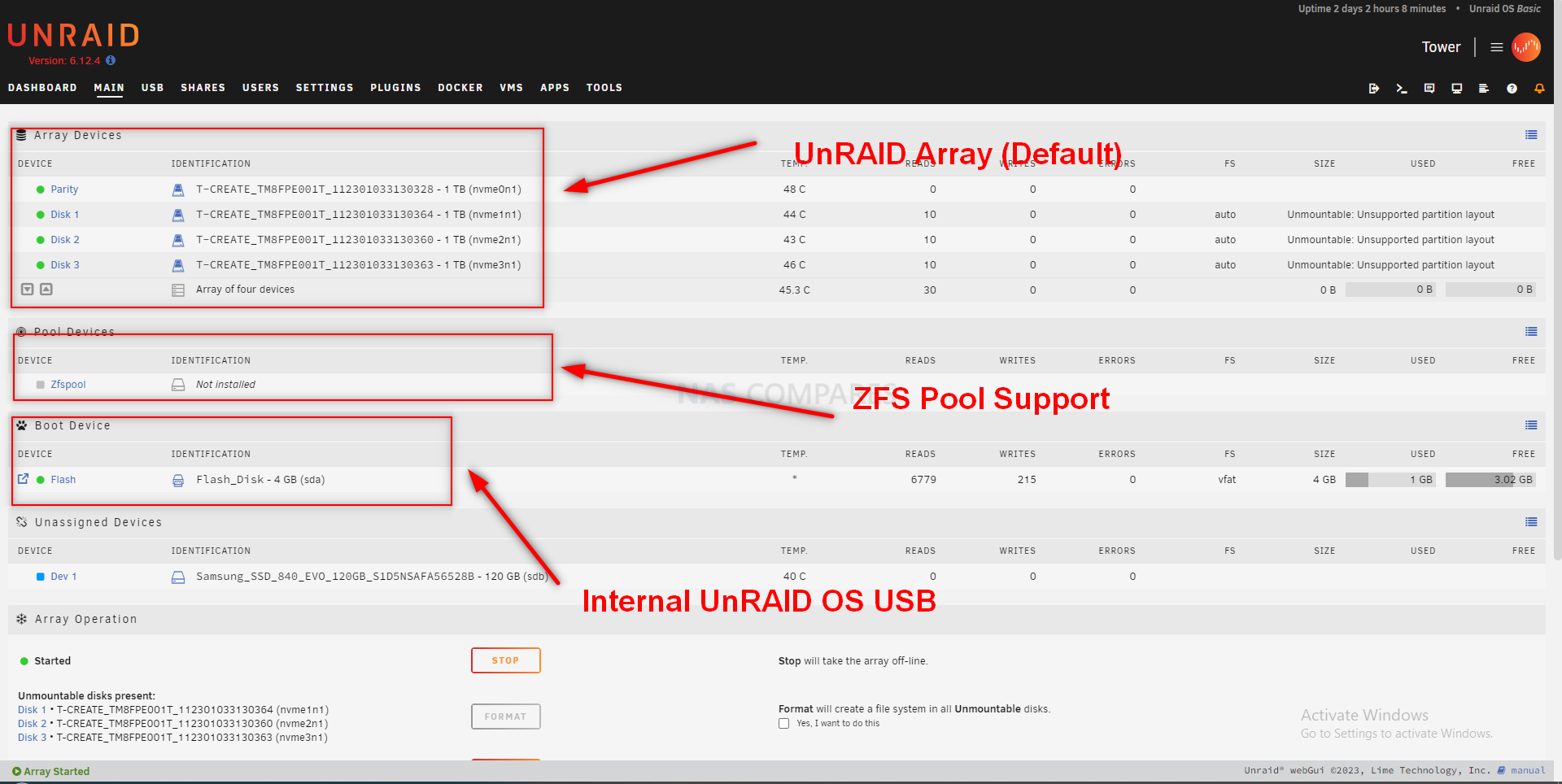
Given that not every user will employ grouped or clustered pools of drives, I wanted to assess the performance of individual m.2 NVMe slots. The read performance of a solitary m.2 NVMe SSD for a 1 Gigabyte data packet is presented below:
Read Performance (without cache/buffer):
- Test 1: 760 MB in 1s => 759 MB/s
- Test 2: 1.1 GB in 1.39928s => 767 MB/s
- Test 3: 771 MB in 1s => 770 MB/s
- Test 4: 1.1 GB in 1.39886s => 768 MB/s
- Test 5: 746 MB in 1s => 745 MB/s
- Test 6: 1.1 GB in 1.44219s => 745 MB/s
- Test 7: 732 MB in 1s => 732 MB/s
- Test 8: 1.1 GB in 1.46408s => 733 MB/s
- Test 9: 744 MB in 1s => 744 MB/s
- Test 10: 1.1 GB in 1.44947s => 741 MB/s
- Test 11: 749 MB in 1s => 748 MB/s
- Test 12: 1.1 GB in 1.42084s => 756 MB/s
- Test 13: 750 MB in 1s => 749 MB/s
- Test 14: 1.1 GB in 1.43599s => 748 MB/s
- Test 15: 742 MB in 1s => 742 MB/s
- Test 16: 1.1 GB in 1.45395s => 738 MB/s
- Test 17: 738 MB in 1s => 738 MB/s
- Test 18: 1.1 GB in 1.45769s => 737 MB/s
- Test 19: 733 MB in 1s => 733 MB/s
- Test 20: 1.1 GB in 1.44167s => 745 MB/s
Contrastingly, here’s the 1GB write performance:
Write Performance (without cache/buffer):
- Test 1: 965 MB in 2s => 482 MB/s
- Test 2: 1.1 GB in 2.22212s => 483 MB/s
- Test 3: 1.1 GB in 2s => 526 MB/s
- Test 4: 1.1 GB in 2.03324s => 528 MB/s
- Test 5: 1.1 GB in 2s => 533 MB/s
- Test 6: 1.1 GB in 2.01558s => 533 MB/s
- Test 7: 580 MB in 1s => 579 MB/s
- Test 8: 1.1 GB in 1.77903s => 604 MB/s
- Test 9: 990 MB in 2s => 495 MB/s
- Test 10: 1.1 GB in 2.1279s => 505 MB/s
- Test 11: 626 MB in 1s => 625 MB/s
- Test 12: 1.1 GB in 1.90571s => 563 MB/s
- Test 13: 980 MB in 2s => 490 MB/s
- Test 14: 1.1 GB in 2.19685s => 489 MB/s
- Test 15: 1.0 GB in 2s => 507 MB/s
- Test 16: 1.1 GB in 2.08995s => 514 MB/s
- Test 17: 628 MB in 1s => 628 MB/s
- Test 18: 1.1 GB in 1.93261s => 556 MB/s
- Test 19: 992 MB in 2s => 496 MB/s
- Test 20: 1.1 GB in 2.1727s => 494 MB/s
The results depict modest performance metrics, particularly when caching or buffering is discounted. However, they still outperform SATA SSDs and are markedly superior to conventional hard drives. Even greater performance could be achievable with the incorporation of ZFS storage pools. Yet, these metrics primarily highlight the throughput enabled by those individual drives on the gen 3 x 1 architecture. In terms of software, the UnRAID bundled with the system remains commendable. Even though Lincplus cannot be credited for UnRAID’s development, kudos to them for bundling it with the N1.
The Lincplus Lincstation N1 NAS Review – Conclusion & Verdict
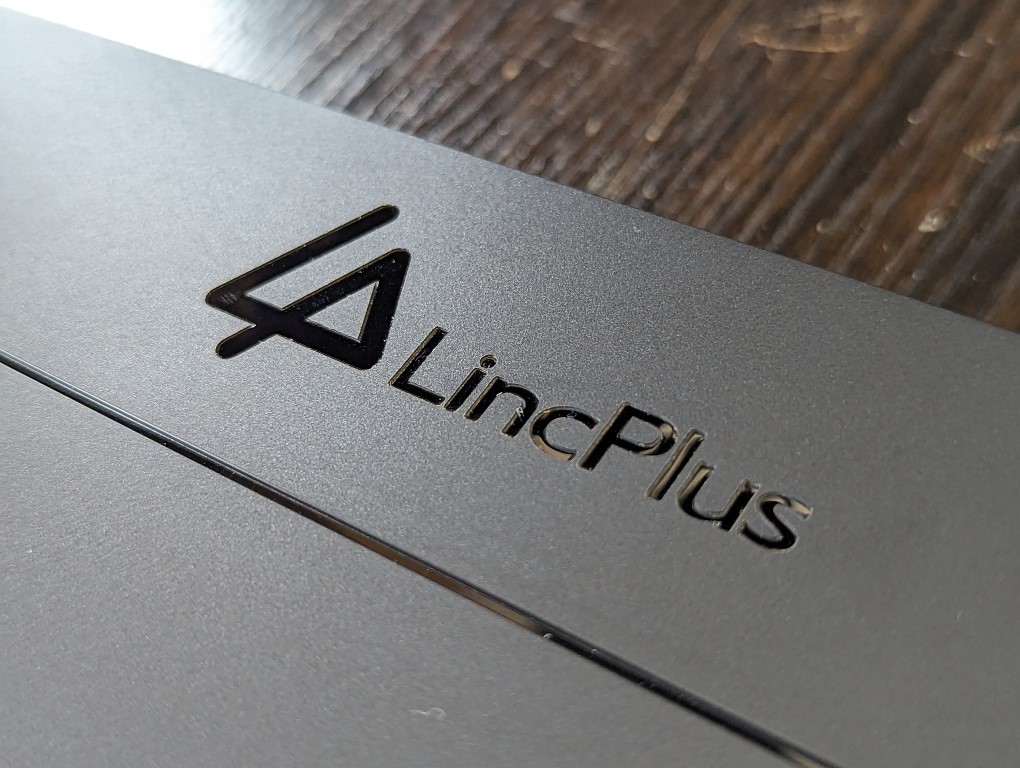
When evaluating the Lincplus N1 NAS, context is paramount. Keeping in mind its price point and the brand’s objectives, as well as understanding how an SSD-centric system can fit into this mold, you’ll likely be thoroughly pleased with this NAS. For a mere $279, it offers an unmatched combination of hardware capabilities. The silent operation, bundled UnRAID software, two-tier storage, and genuine turnkey out-of-the-box deployment culminate into a device brimming with potential. It caters to both newcomers to private server ownership and seasoned home lab enthusiasts. Certain concessions were inevitable to attain this attractive price. Seasoned flash industry professionals might bemoan the absence of ECC memory, the use of a consumer-grade CPU, and limitations placed on the bandwidth and speeds for the m.2 NVMe slots. Even though the software is genuinely turnkey and the system is ready to run immediately after unboxing, UnRAID does come with its learning curve. It might be more user-friendly compared to other container-based GUIs, but there’s still a learning curve. Additionally, the default UnRAID settings could be better tailored to this SSD-driven system. Hopefully, future firmware updates might address this. Such discrepancies are expected when the hardware is developed by one entity and the software by another. This dichotomy can lead to inconsistencies, such as those seen in drive monitoring results, raising questions about the demarcation of responsibility between the two entities. However, overlooking these minor points, the N1 stands out as a commendable alternative to a full DIY approach. It not only saves money and time but also offers a ready-to-use, compact solution. Provided you acknowledge and accept the inherent compromises, the N1 emerges as a notable midpoint in the burgeoning server market, bridging the gap between custom-built and all-inclusive turnkey solutions.
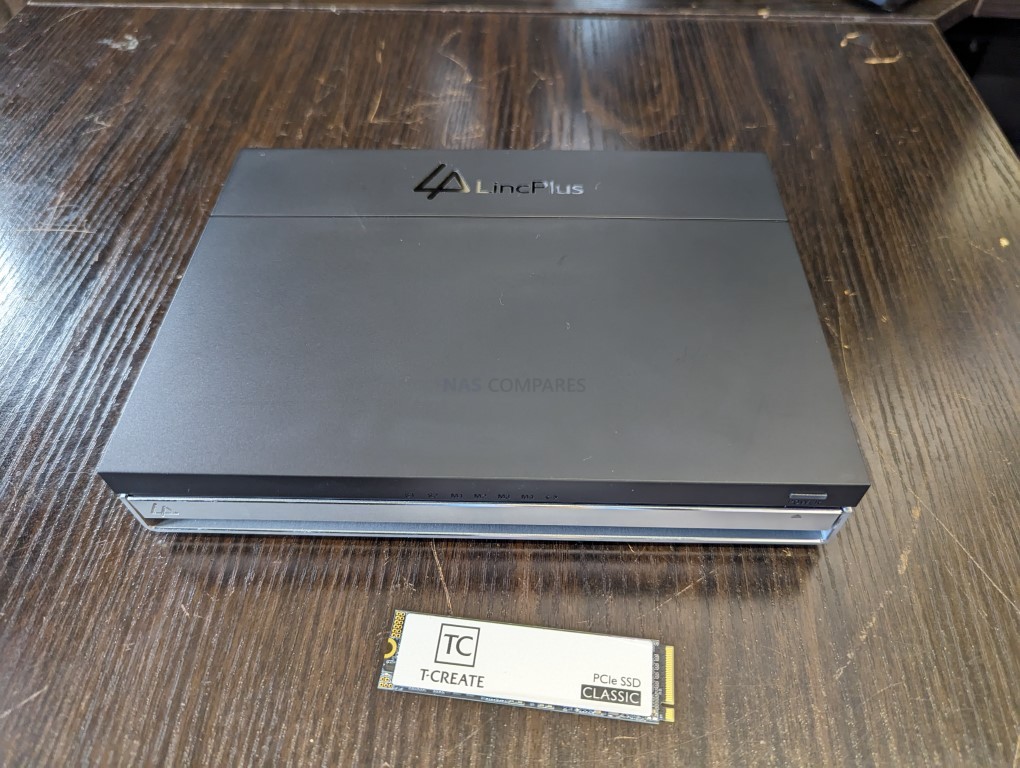
|
PROS of the Lincstation Lincplus N1 NAS Very Affordable at $279 (IndieGogo Price) |
CONS of the Lincstation Lincplus N1 NAS UnRAID is not Tweaked for this SSD Focused System |
🔒 Join Inner Circle
Get an alert every time something gets added to this specific article!
This description contains links to Amazon. These links will take you to some of the products mentioned in today's content. As an Amazon Associate, I earn from qualifying purchases. Visit the NASCompares Deal Finder to find the best place to buy this device in your region, based on Service, Support and Reputation - Just Search for your NAS Drive in the Box Below
Need Advice on Data Storage from an Expert?
Finally, for free advice about your setup, just leave a message in the comments below here at NASCompares.com and we will get back to you. Need Help?
Where possible (and where appropriate) please provide as much information about your requirements, as then I can arrange the best answer and solution to your needs. Do not worry about your e-mail address being required, it will NOT be used in a mailing list and will NOT be used in any way other than to respond to your enquiry.
Need Help?
Where possible (and where appropriate) please provide as much information about your requirements, as then I can arrange the best answer and solution to your needs. Do not worry about your e-mail address being required, it will NOT be used in a mailing list and will NOT be used in any way other than to respond to your enquiry.

|
 |
UGREEN DH4300 & DH2300 NAS Revealed - Good Value?
Aoostar WTR Max NAS - Should You Buy?
Xyber Hydra N150 NAS Review - Is This COOL?
Minisforum N5 Pro vs Aoostar WTR Max - The BIG Showdown
Do MORE with Your M.2 Slots - GREAT M.2 Adapters!
5 Top Tips for Content Creators Buying a NAS
Access content via Patreon or KO-FI


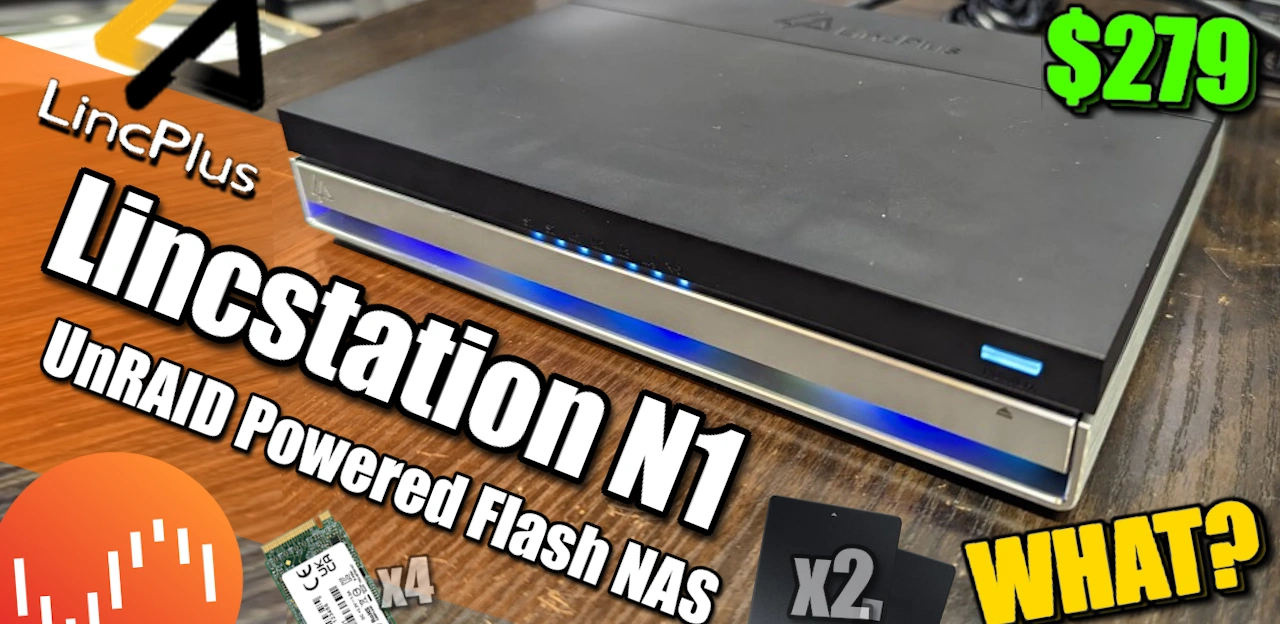
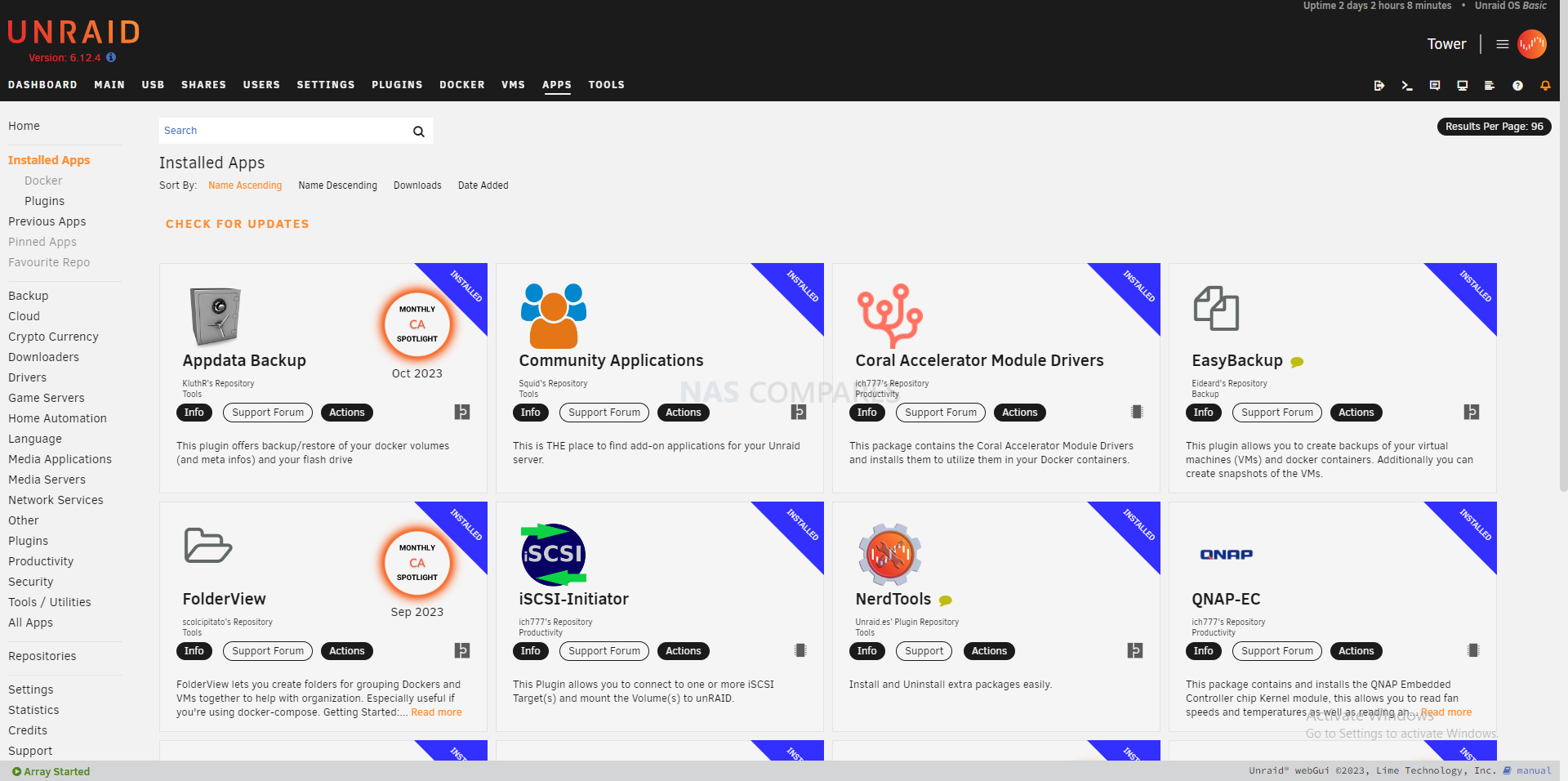
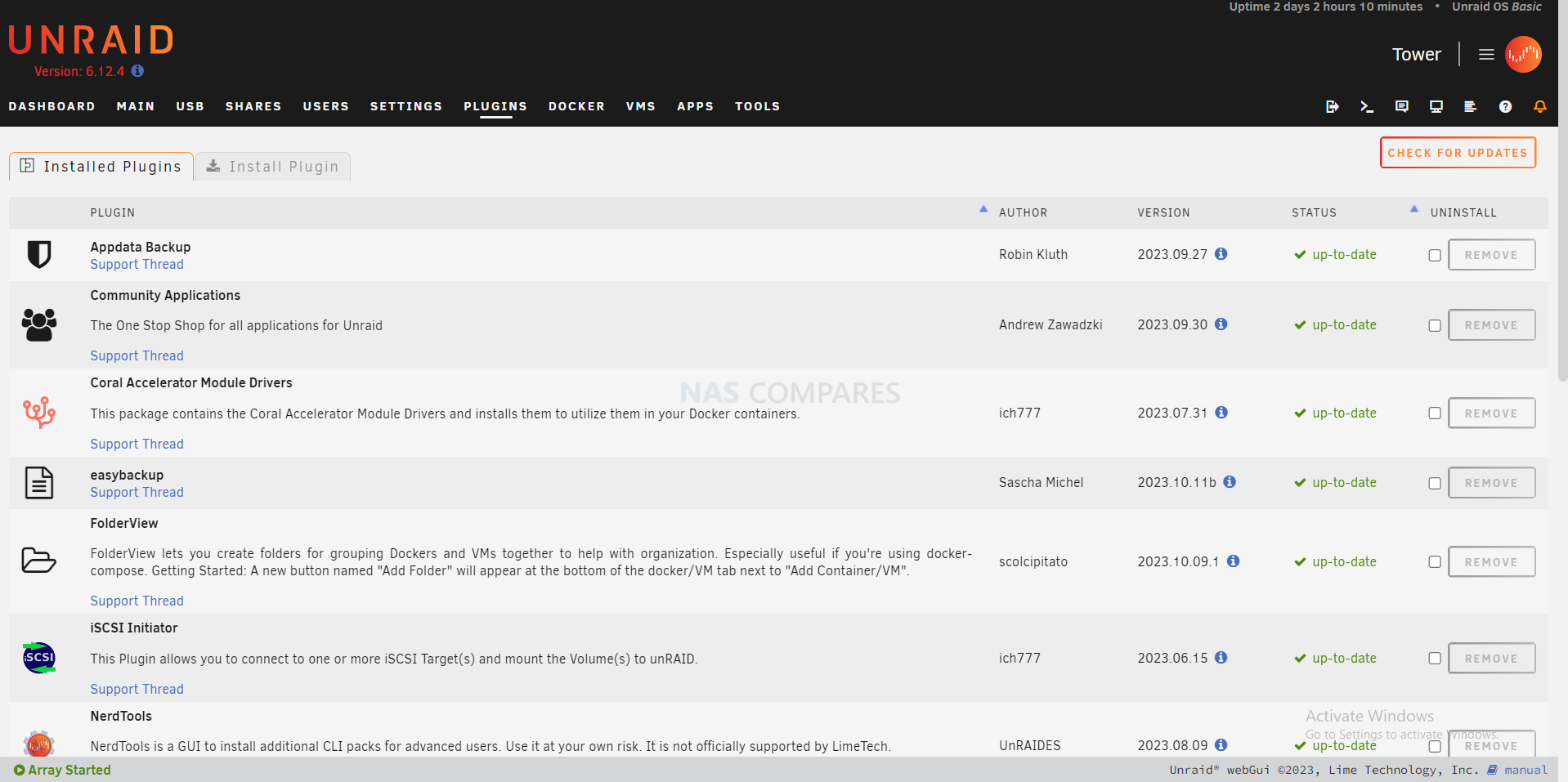
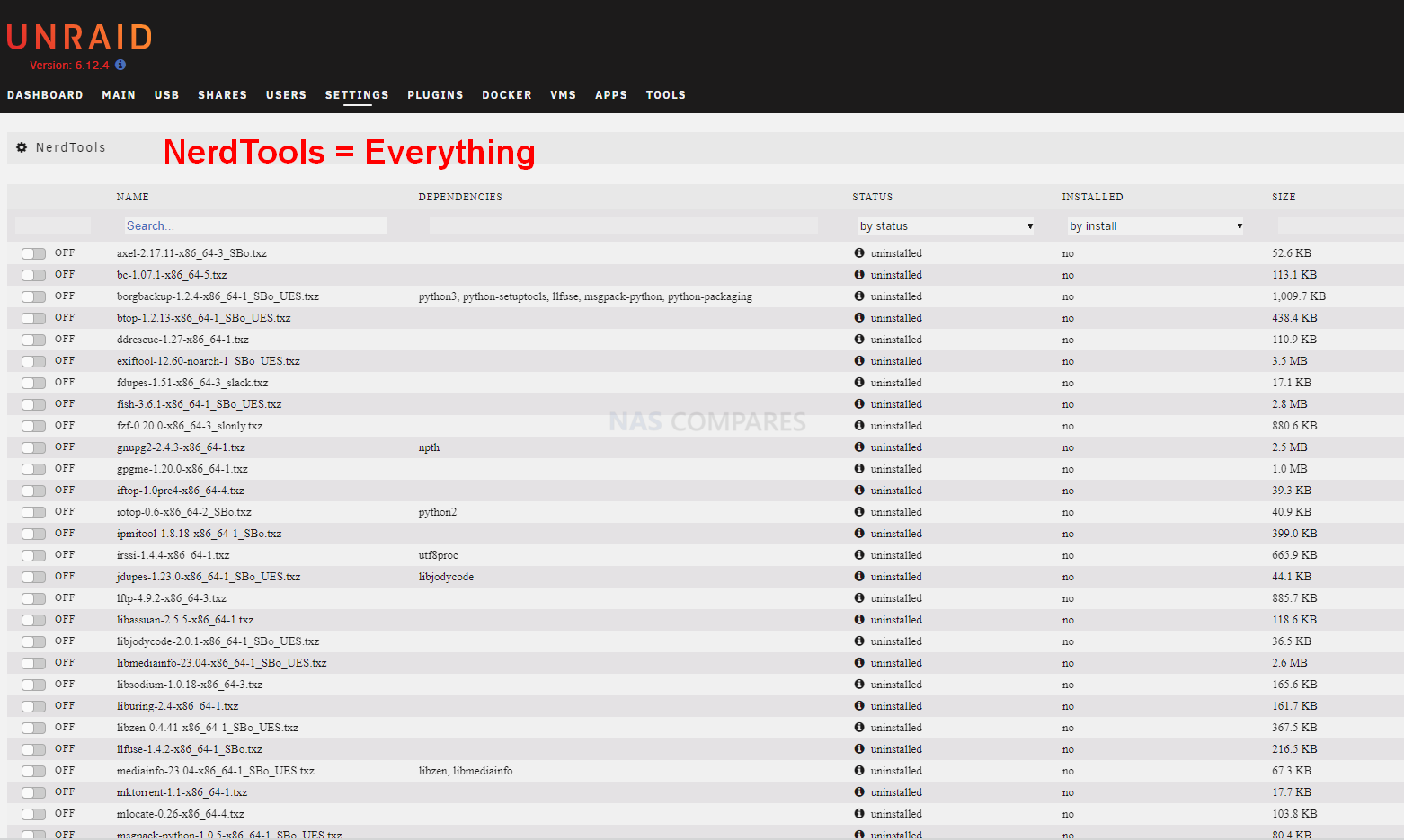



UnRaid FTW
REPLY ON YOUTUBE
That’s a great review of the LincStation (I have been given a sample to test too) I wanted to comment about your speed tests with and without cache. My first thought is that I wouldn’t want to lose a slot to cache given that 8TB SSDs are still very expensive, and that would knock 4TB off the array I have setup too, so what about using a 1TB USB drive and assigning that to the cache? I have a Basic Unraid license so I am even wondering if this can be done purely for testing purposes, will have to try it tomorrow.
REPLY ON YOUTUBE
I am using my DYI Unraid server serveral years now. And I love it. Additional I installed or rolled out several synology NAS to very small companies. I find the biggest advantage to Unraid is also its biggest disadvantage -> Freedom of choice. With Synology I just buy the device I need for e.g. SMB Share and Client (Windows 10) backup and 1-2 docker. With Unraid it starts with which case, which PSU, which CPU etc. – When you start researching what hardware to buy, you easily fall into the rabbit hole. After hours you still have no shopping list for the unraid server.
REPLY ON YOUTUBE
My vote goes to Unraid
REPLY ON YOUTUBE
I bought synology for moments and photos to get away from Google photos after they brought in their caps.
But overall it’s fairly disappointing, I was expecting more updates and features. I’m here watching this to work out whether to sell my synology and just go with unraid.
REPLY ON YOUTUBE
I wish I would have know about Unraid before I bought my expensive qNap. Not shortly after I purchased, they had the issue with the software and many qNaps being bricked unless you paid to unlock. I did my research first on the NAS but never considered or thought about building my own from left over parts. I have had nothing but problems in which the company did not know why and them not wanting to replace. So now to ensure I have all my data, I off sync weekly to a cloud system till I am able build an Unraid System for myself. What irritated me most was how my network was a home private network that the qNAP allowed invaders now into my home. So then after, i watched more videos of how to keep my self protected; did what they asked and had issues with creating their containers for pfsense then to the qNap to be told, my model is too old or missing the necessary specs. Well, it turns out to be my specific qNap — that has the issues not specifically the model. The help is not there from qNAP if the warranty is gone. That to me made me realize its better to build your own know everything is possible. Now I am looking to turn my qNAP into an unRaid once i figure out how to do it. When I found about SpaceInvaderOne — I watched all his videos from the beginning to current and was amazed with the community that was there willing to help. But I enjoy the discussions! Thanks
REPLY ON YOUTUBE
Great video! Keep up the good work for both…
REPLY ON YOUTUBE
I think I can make a good comparison, since I am using 2 x qnap NAS one is TS473A with 32GB ram and 2 x NVME plus 4 x 4TB SSDs and the second one is only a 2 Bay 8GB ram 2 x 12 TB hdd, at the same time as a main home server I am using an Unraid with 3900x AMD 64GB ram 4 x 8TB U.2 zfs pool with a couple of NVMe caches without a reel Array, since an Array is too slow for me. I like really QTS especially QuTS Hero, because it is really very straight and easy to use. As a normal Nas just for file sharing using smb, qsync, hmb backup and a couple of small.comtainers it works very well, but sometimes I get crazy because it gets too slow since the compute power is really very bad. You pay 1000 bugs for only quite good nas like TS473A with 32 ram, then you get a terrible cpu which stocks if it needs to make parallel a couple of works. But in case unraid I can for same price much better hardware, besides that you can make thanks speceinvaders videos nearly everything what you need for a server and consumer pc.together. you can expand unlimited and use every app.docker or vm. Sometimes it is a little bit difficult to understand why it should be exactly that way, but this is really not a con. The TS473A is working with my unraid almost redundant, all shares are being synchronized immediately and the Ts231 is only for backup, which has no regular internet connection. Qnap has very good mobile apps, for example qsync is in my opinion one of the best in its class or qfile, since I am using still qfile if I am outside, instead unraid with vpn. The snapshots in QuTS are just fantastic compared in umraid, because in unraid it is not so easy and managable like in qts. Finally I recommend both unraid and a turnkey Solution, since a turnkey solution is good for backup and file-sharing, but who wants to make experiments on a home lab cheaper then they should try unraid but for unraid and co. You need o bring some linux knowledge
REPLY ON YOUTUBE
5:50 There’s no such thing as a 4090ti.
REPLY ON YOUTUBE
TrueNAS scale > Unraid!
Just because it’s made for professionals and build around ZFS! Yes unraid has now ZFS support but it’s a patchwork.
REPLY ON YOUTUBE
I just watched this video from techone about how most modern raid systems don’t properly correct bit rot or parity errors. This was shocking to me. Seems like only ZFS provides the error checking and correction and all of these NAS systems are not protecting our data? Please provide your opinion on this problem.
https://youtu.be/l55GfAwa8RI
REPLY ON YOUTUBE
This guy took a long time to explain what it’s like to be poor.
REPLY ON YOUTUBE
What about a video of using QuTS or DSM on dedicated PC as NAS OS… Not really legal but anyway… it exists :DD
REPLY ON YOUTUBE
I have two of those Buffalo ls220 NAS ‘s on my coffee table right now they live their.
REPLY ON YOUTUBE
After more than 12 years of Synology (1621+ was the last one), I’ve been using an Unraid system for 4 months and don’t really look back to Synology. For users without interest to look under the surface, Turnkey is 100% the right choice. Unraid and similar systems require an interest in the system. In principle, you have to have a basic understanding of Linux. The more, the better 😉
REPLY ON YOUTUBE
Nice shirt Robbie!
REPLY ON YOUTUBE
Great discussion. Ed’s the best.
Both solutions definitely have their benefits depending on your need and desire for tinkering. I got started with Unraid on a old PC and it’s been great getting me started down the rabbit hole. Obviously, spaceinvader has been invaluable. I’ve since bought a DS923+ to get familiarized so it can eventually be set up for remote backup at the parent’s house. Definitely seemed to be the best solution to set up for them as something that they can also actually use. Honestly, I might keep a synology around in house just for Photos as it seems to be the best option for my needs that I’ve come across so far. Otherwise, the flexibility of unraid is just what I want for everything else. And, yes, it’s fun.
REPLY ON YOUTUBE
Turnkey NAS also has included some free services like surveillance, email accounts, office and phone apps.
REPLY ON YOUTUBE
Both paths have big plusses and minus to them and it comes down to what someone *really* wants when managing their data.
The big differentiator for me though is usually when things don’t go right. For instance, sure you can buy an HP retail server to then install Unraid, or other, onto it. But the thing is when you are having issues what help and support will you get from HP when it goes wrong. In so many cases with mixed environments I’ve seen one provider point the finger at another. So one really has to be careful with what warranty one actually gets when you go off reservation. In a lot of cases 1st party manufacturers will require a specific software install to be present before they’ll even help you. Support costs actually make up a surprisingly large part of a unit’s overall cost.
As for having to send your turnkey NAS in to the manufacturer for any sort of repair. Yes that’s entirely true and often for such small things. That said, for many of the Synology NAS devices you can get the extended warranty for something like $50. This not only give extra warranty but it also opens the door whats of greater value to me and that’s the expedited exchange service where once an RMA is agreed, Synology will send give you the option of having them send you out a replacement *BEFORE* you need to send in your RMA device. You then have 28 days to get the RMA device back to them. This is handled with Synology directly and not through your reseller/wholesaler.
The other big differentiator is the ease at which you can get high system density. Yes, you can DIY yourself some very dense systems but the easiest way to get it is with turnkey. I don’t know about anyone else but my floor and shelf space costs money.
PS My Synology RS1221+, 2 x DS620slims, RT6600ax wifi, Ubiquiti DM-SE and 24 PoE switch all operate in under 100W.
REPLY ON YOUTUBE
I don’t think you should talk about winners here. Both solutions have a different approach to the same problem. I have a little experience with TrueNAS and I’ve been looking to move to unraid, but it required time investment to do the things I want, while a turnkey solution has them out of the box with little configuration. If someone who’s not tech savvy ask me for what NAS to get I would tell them a turnkey, but if it’s someone tech savvy I’ll definitely point them to any of the free solutions (and he probably has an old pc lying around to use). It almost feel like, do you want take out or do you want to learn to cook, one is easy the other takes time but in the long run is more rewarding. And also, when I was job hunting, putting in my curriculum that I know how to deploy a NAS, even if it was not relevant to the job, it gave me some talking time to at least show I can self teach me things and pretty much gave me the title of the tech guy (for better or worst).
REPLY ON YOUTUBE
I went with the QNAP 8-bay TVS-h874 i9. So far working well.
REPLY ON YOUTUBE
Great video. Lots of fun to watch and see the comparisons
REPLY ON YOUTUBE
Excellent comparison video. Great high-level overview of each platform. Thanks!
Just bought my first turnkey solution for ease of maintenance and low power consumption, but as a tinkerer, the UnRAID DIY environment speaks to my heart.
REPLY ON YOUTUBE
I had Unraid before going to Synology DSM. The reason I switched was because I found installing apps/dockers on Unraid to be unnecessarily complicated. One really has to know their way around Linux to make it work. Synology DSM is just easy and I can install all the apps I need.
REPLY ON YOUTUBE
Space invaders videos have helped me learn unraid and the videos have been invaluable. I love unraid! I tried truenas scale and I couldn’t get any apps or VMs to work, and OMV is kinda underpowered especially on a Pi4 (which is what started me down this road)
If turnkey floats your boat, do it. If an old Pc as all you can afford, do it. I built a modern NAS using a fractal define R5 and a couple 8 terabyte ironwolfs
REPLY ON YOUTUBE
Great idea for a video, thanks for sharing ????????
REPLY ON YOUTUBE
awesome conversations with very smart people, both of you; as “turnkey” nas user (and very happy about it) i will continue using it, but i do understand the point of spaceinvaderone during the conversation.
P.S. i found the turnkey nas, as fun as the builted from scratch ones; servers are awesome
REPLY ON YOUTUBE
Great video guys! Thank you.
REPLY ON YOUTUBE
Great video. I’m on team turn key but I think we could add “hardware reliability”. Thanks to the fanless power brick and low heat emission we have an extra layer of durability and reliability.
Although it was a great video to peek in to Unraid. Looks fun to play around on used parts.
REPLY ON YOUTUBE
It’s great you have a free Q&A service but I asked a question about three weeks ago that therefore has not been answered within the 3-5 days
REPLY ON YOUTUBE
considering im buuilding a NAS tester box, this is a great vid for me to get ideas of alternates to my great Qnap box, i already know there are limitations of it, but i use the poor thing to its limits, and already need more storage as 32TB doesnt seem to be enough for my wife, holy crap she can fill that box up. (my ripping bluerays and stuffing the mildly compressed MKV’s dont help i guess.
im glad i moved to a RAID box, i already had 1 scare where drive 3 had a super minor glitch and the raid took it offline for me to check, and rebuilt it back after i found there was nothing wrong and has been working flawlessly ever since, im sold on these types of solutions. oddly enough even being in the tech field since ’80’s i still never bothered with RAID even though i owned IDE raid card, i never even tried to use it beyond a simple IDE controller. well, im trying it now.
it is my opinion, if you are buying a NAS settup and only plan on having a couple of terrabytes or loading it up with drives smaller than 10TB, do NOT waste your time with turnkey.
i also dont like the idea of TK NAS boxes using chips old enough to be in my old dell netbook.
i would like more info on using boxes like Qnap’s jbod boxes (ie: TL-D800C or TL-R1200S-RP) with unraid/TruNAS setups. (video please, yes ill check his site on this stuff too)
REPLY ON YOUTUBE
Thanks for all the useful info , great????
REPLY ON YOUTUBE
Enjoyed the video thanks 🙂 I ordered the DS1522+ recently (got it used for $550 from Amazon and will have in a few days). Also acquired 3 x 14TB Seagate Exos HDD for $115 a piece from Ebay — will get those about the same time. The Synology can do a lot of neat things and I think I’ll use it for a while and perhaps also setup an Unraid or Truenas. I used to have an unraid system about 10 years ago but sold it after using it for a year because I needed the money at the time. Nice to know unraid supports virtual machines, containers, zfs, etc. now. I’ll probably setup a TrueNAS Scale system next and then perhaps an Unraid as well, just to learn them all for fun.
But looking at what all Synology can do so easily it’s giving me a lot of good feelings inside lol. Much like Novell Netware 3.11 did back in 1991 🙂
Part of my challenge for setting up a Truenas or Unraid system is finding something that is power efficient and also works with ECC memory. I was considering the Dell Precision 7820 but I read it uses like 130 watts idle. Bleh.
REPLY ON YOUTUBE
Absolutely brilliant discussion subject matter and expertise. Well done
REPLY ON YOUTUBE